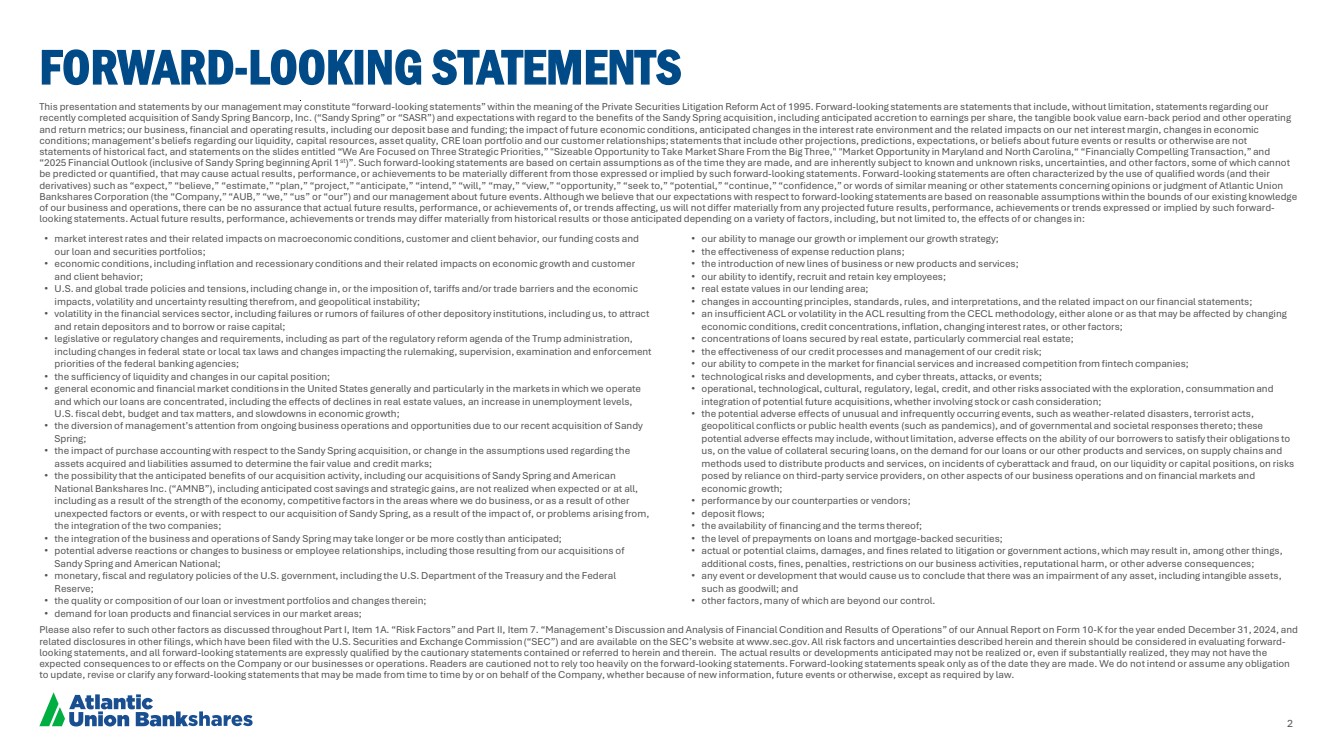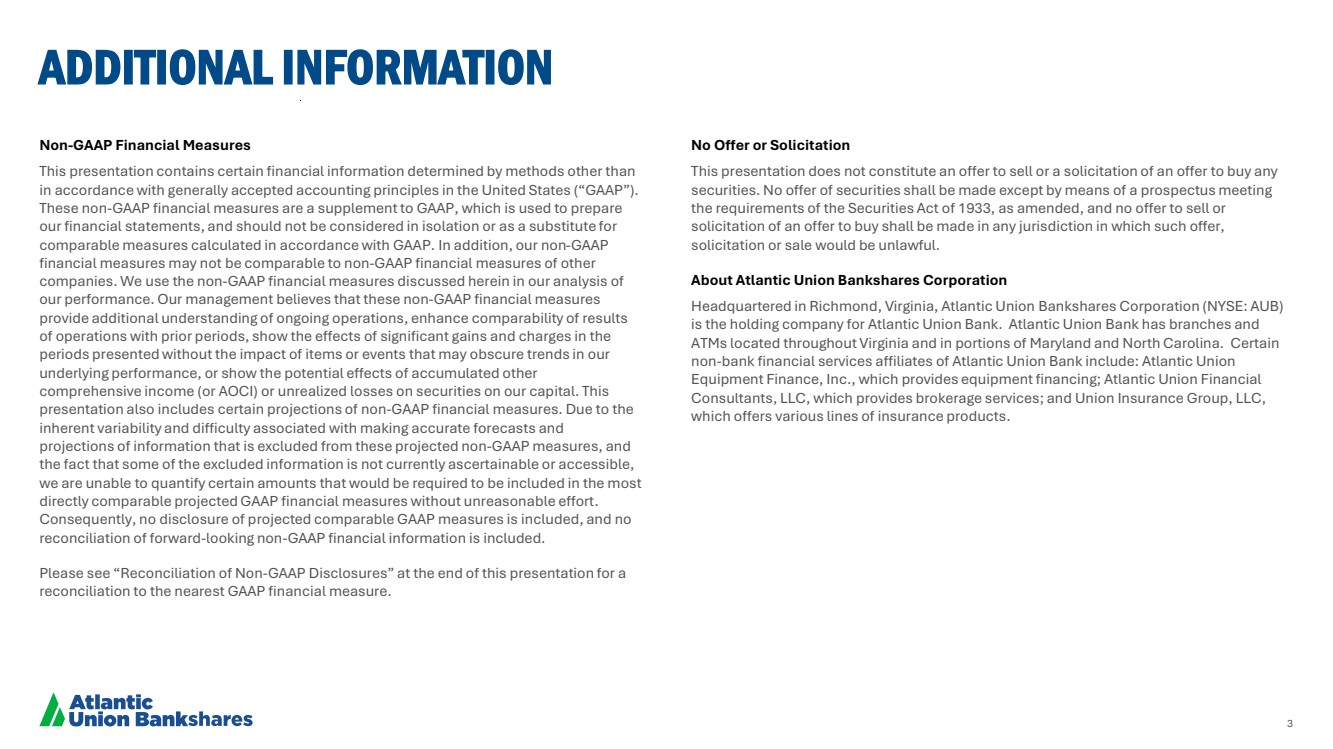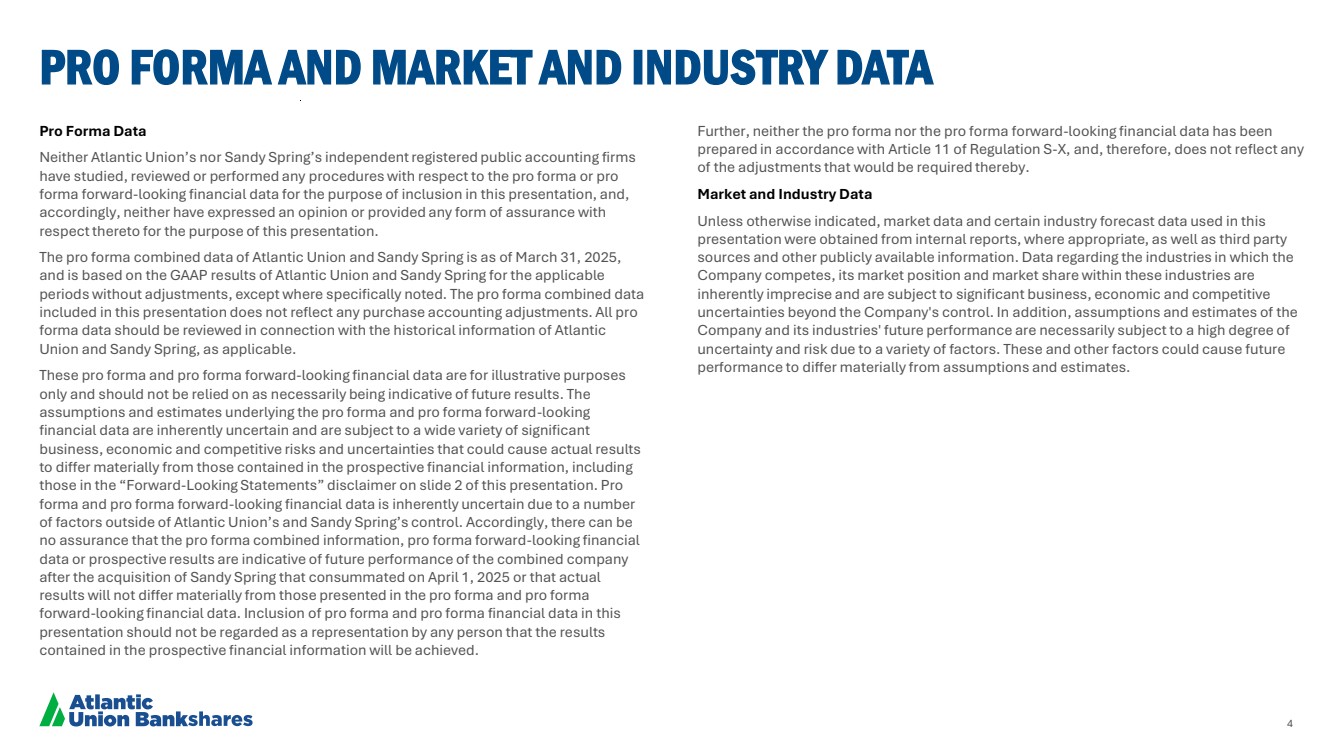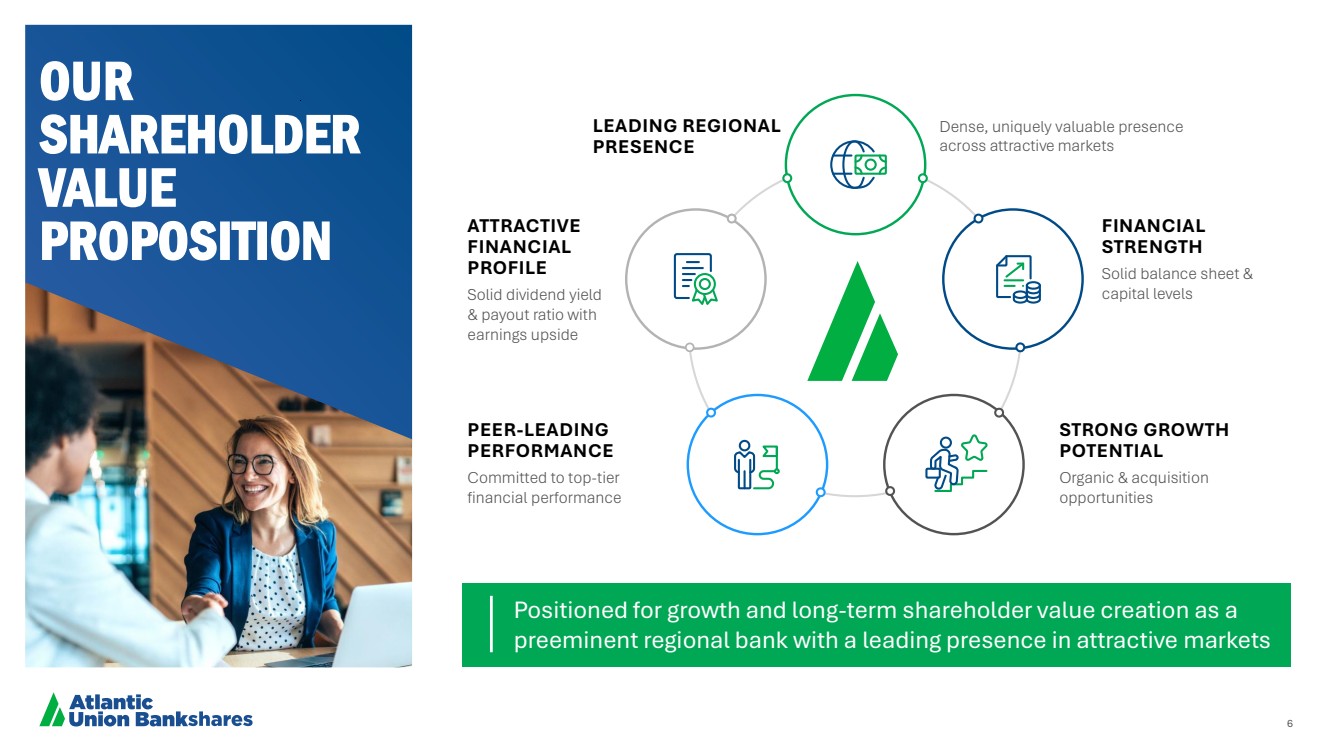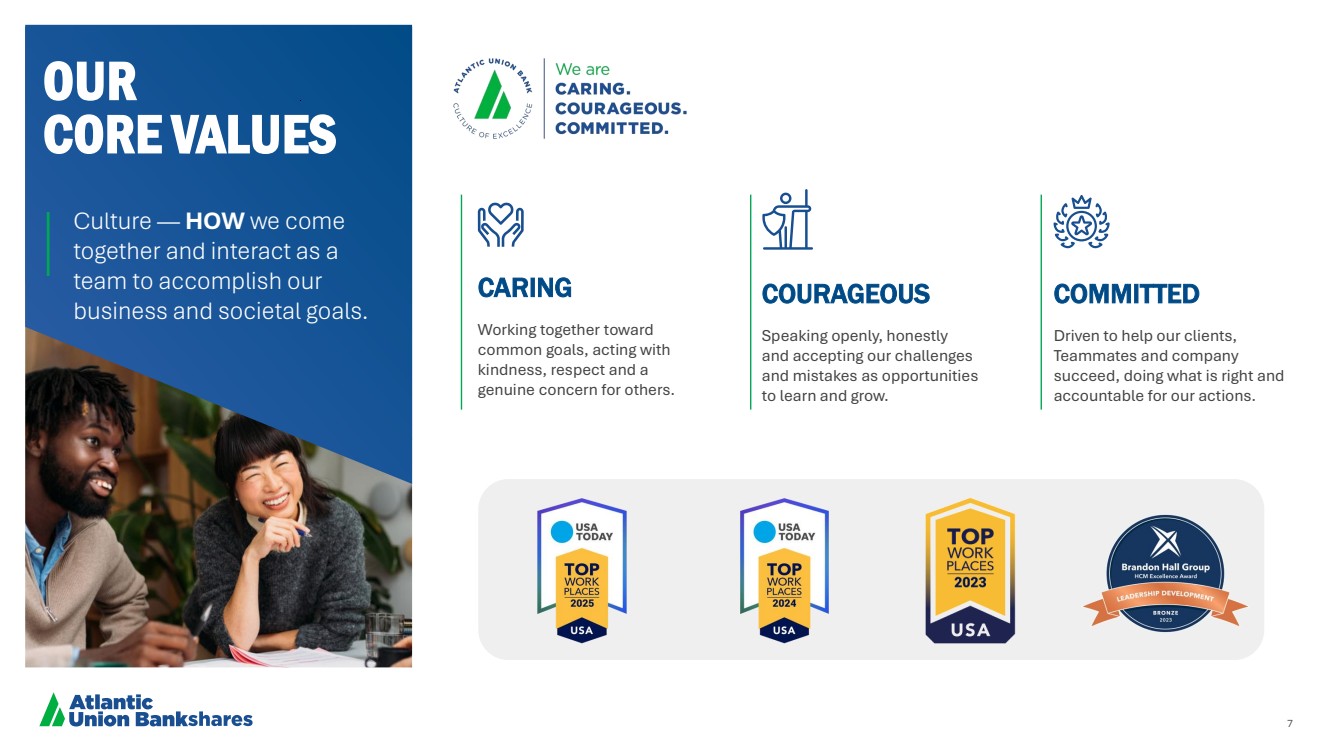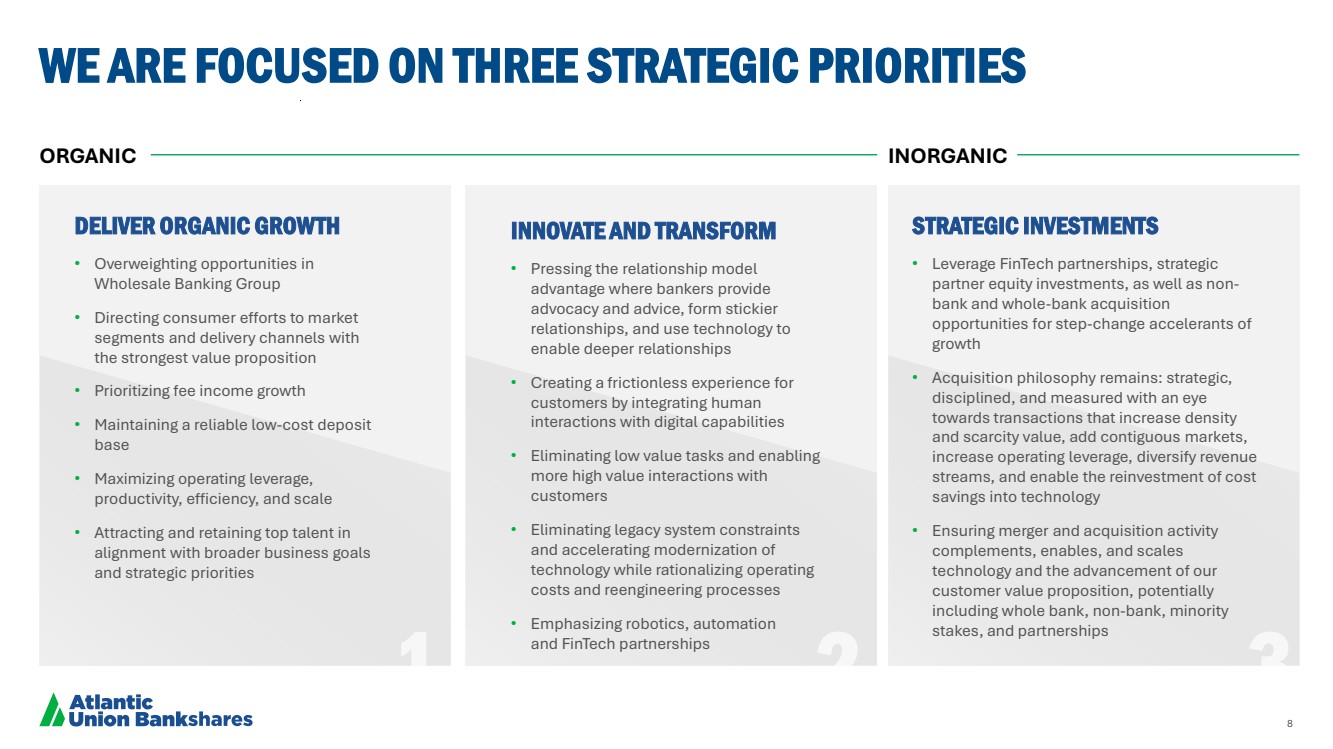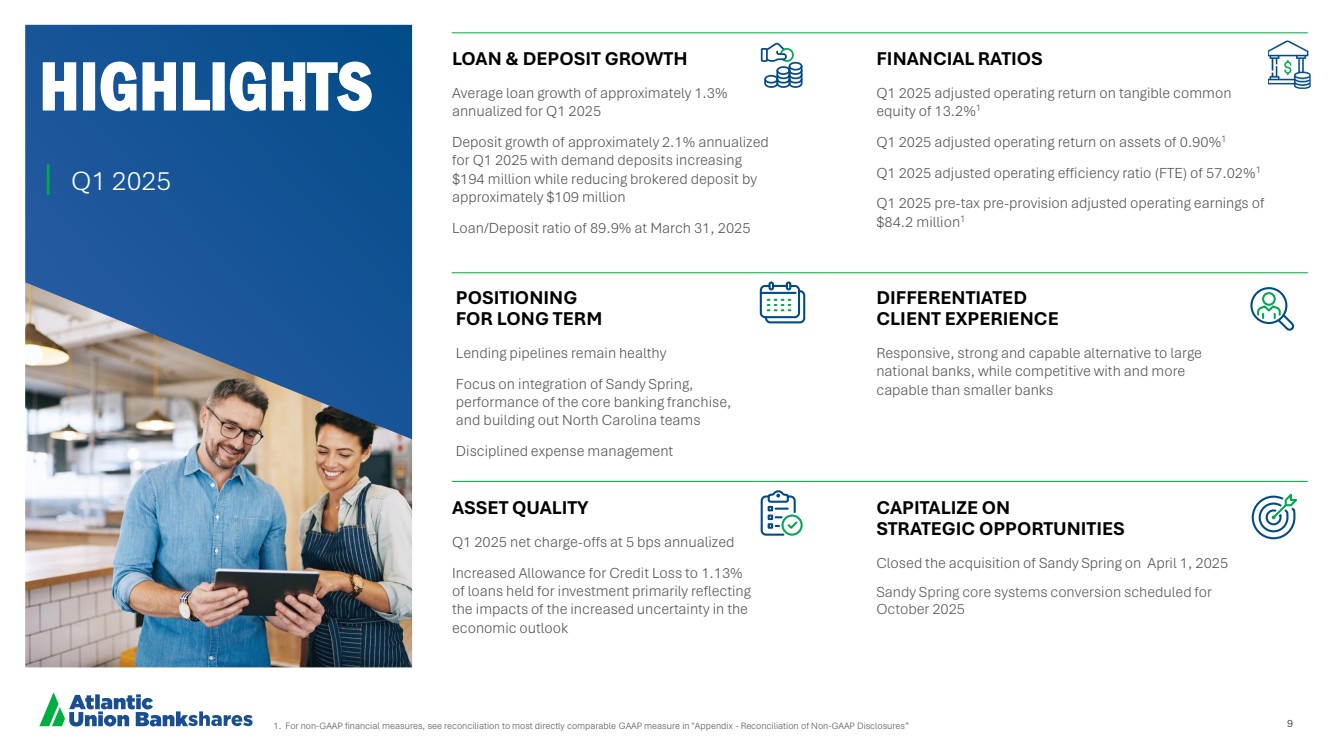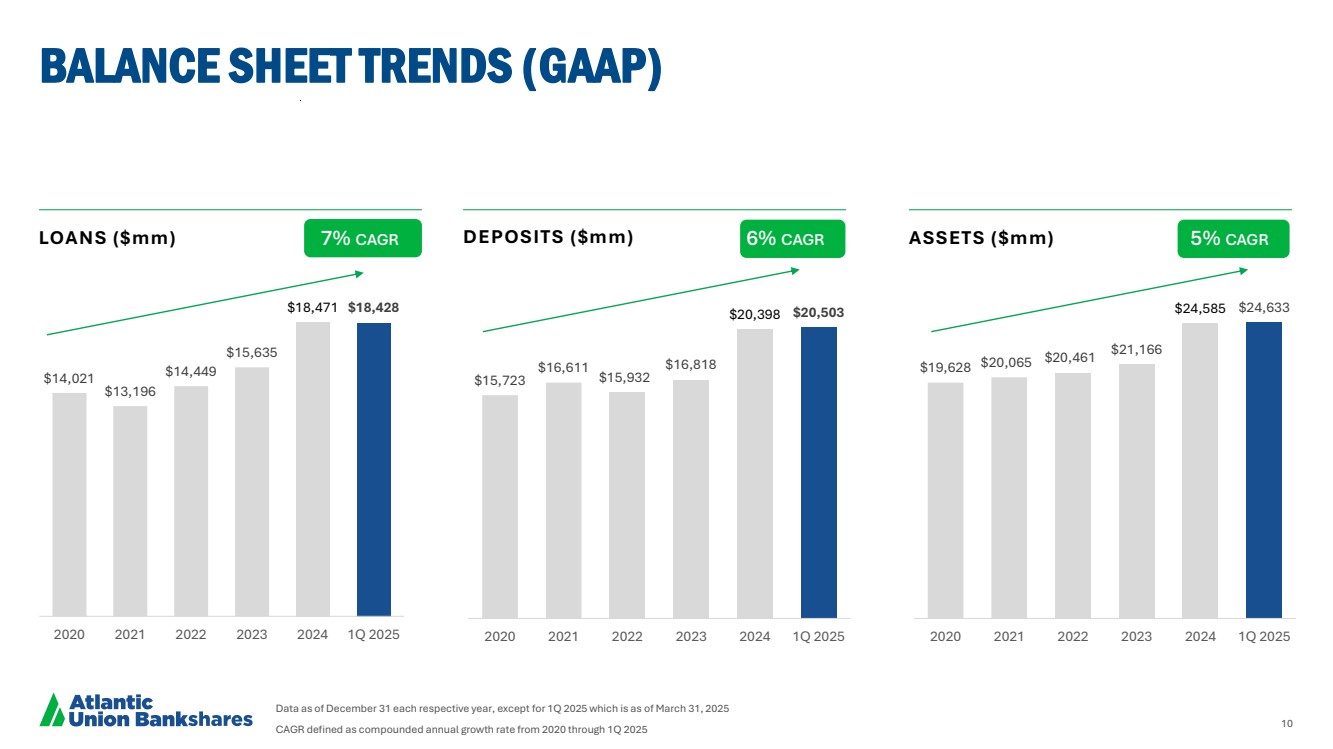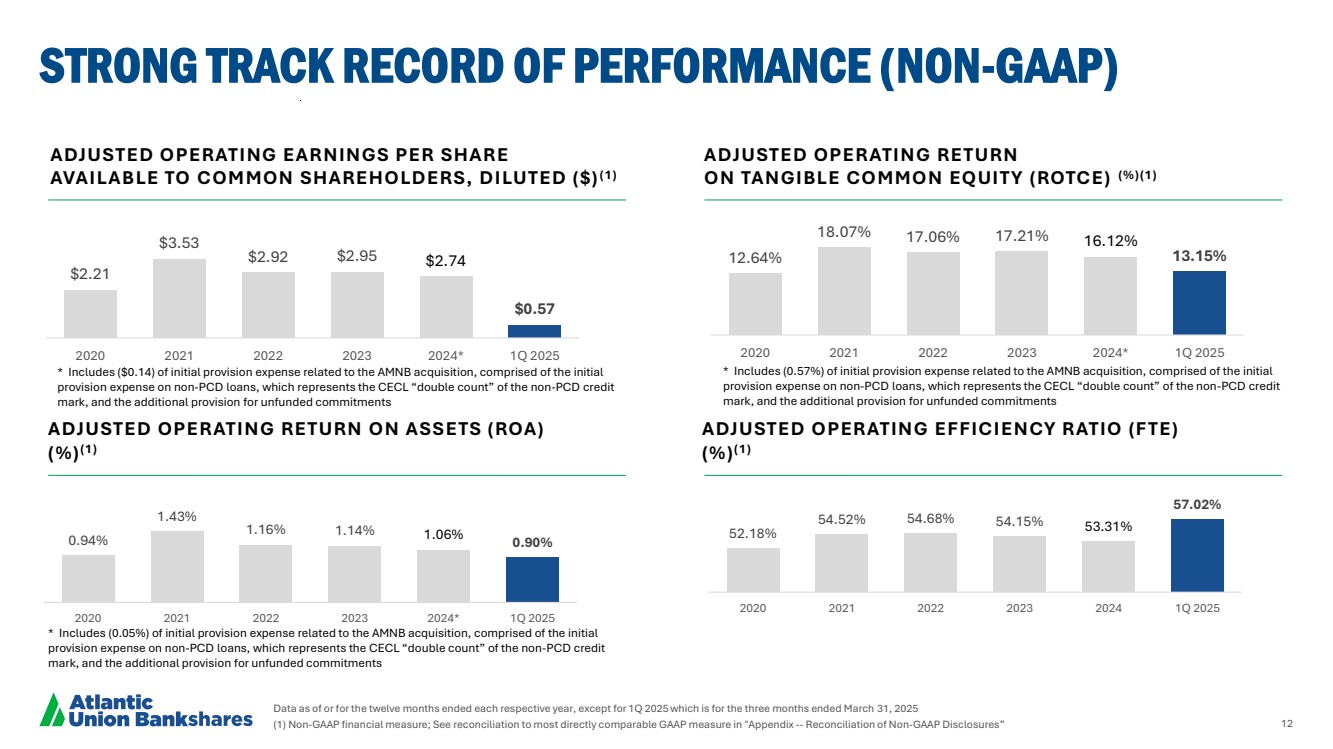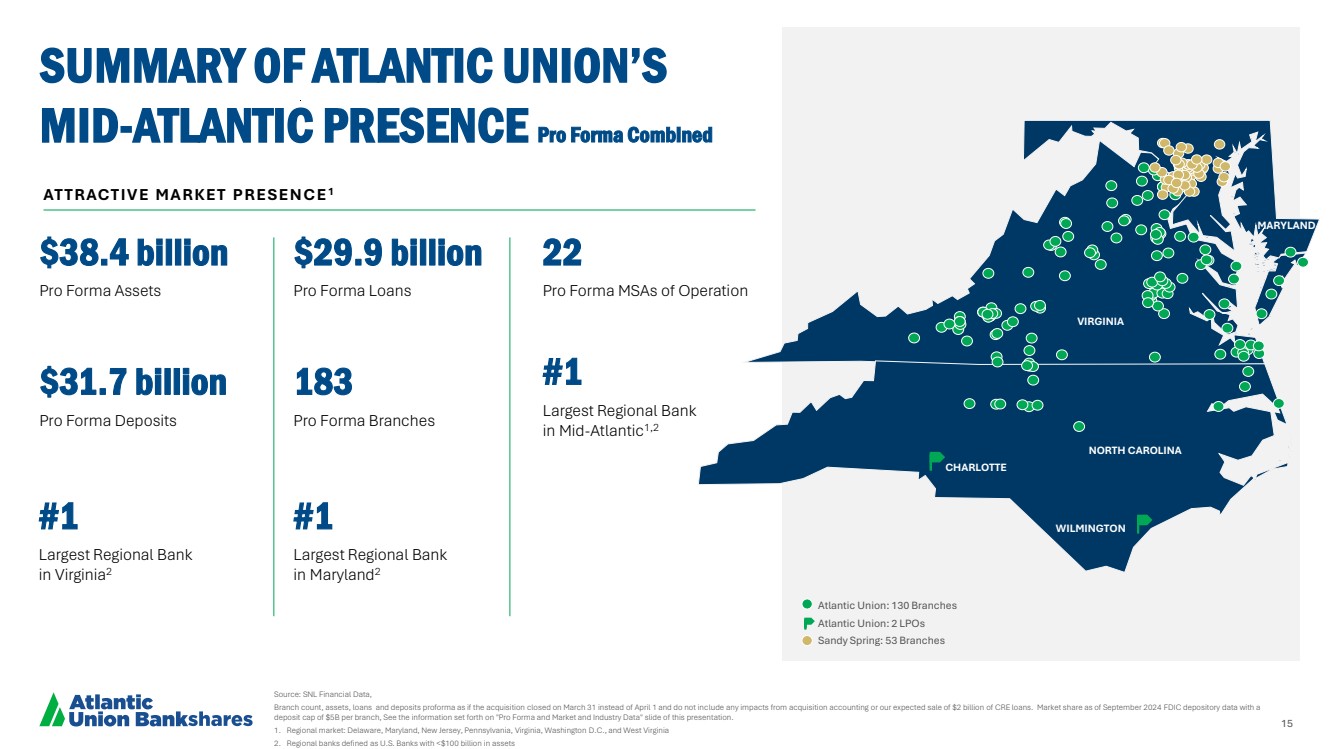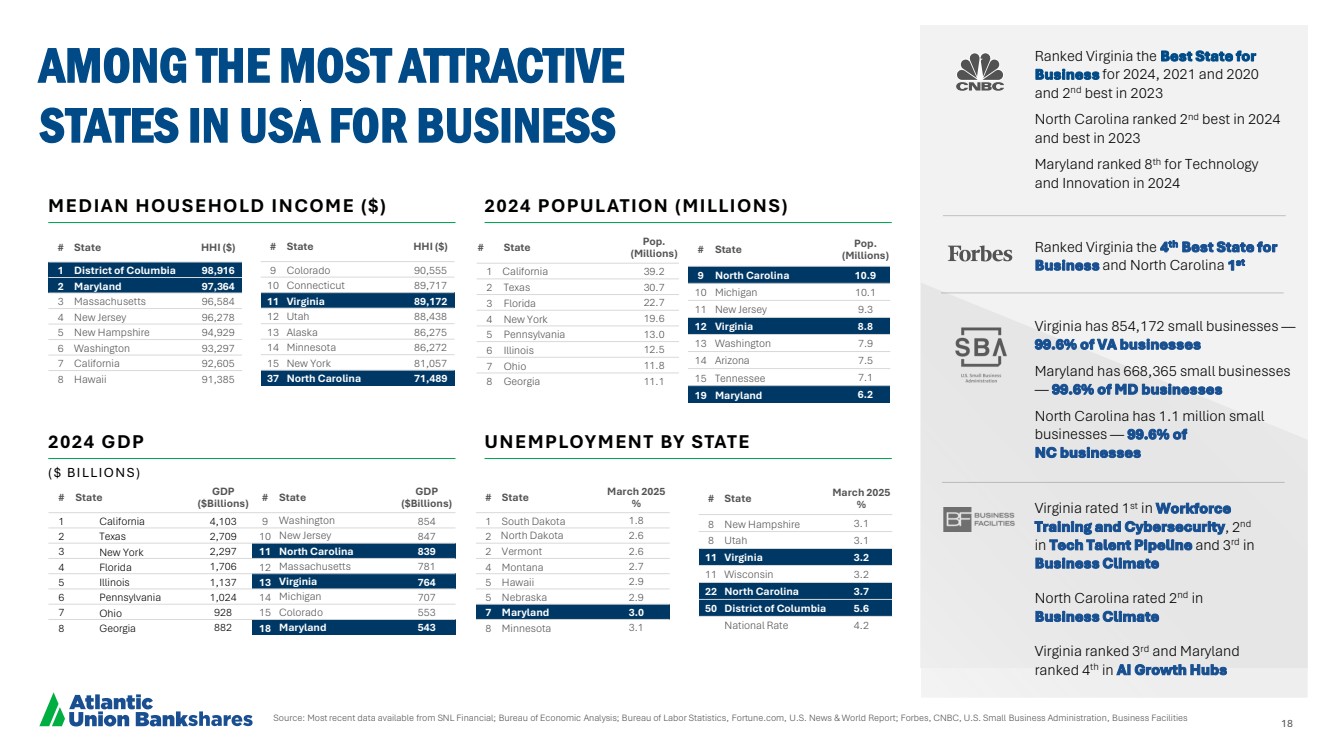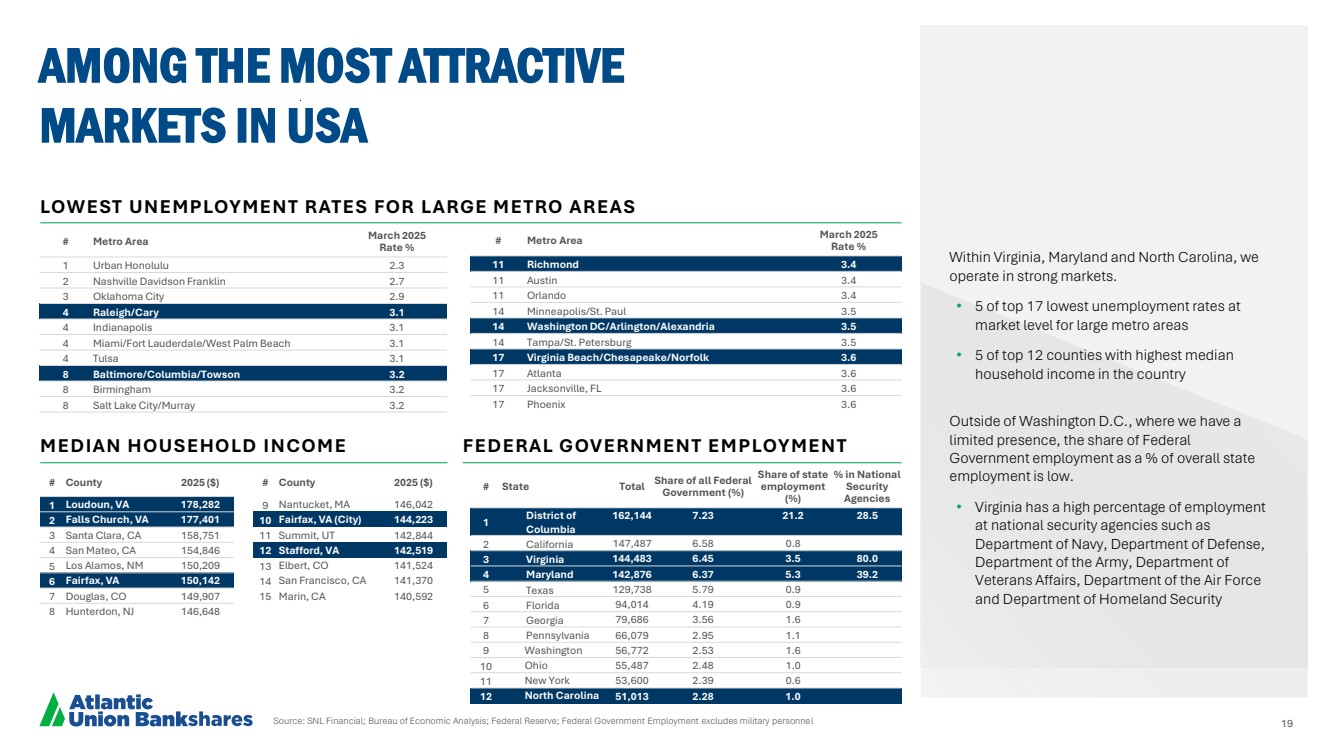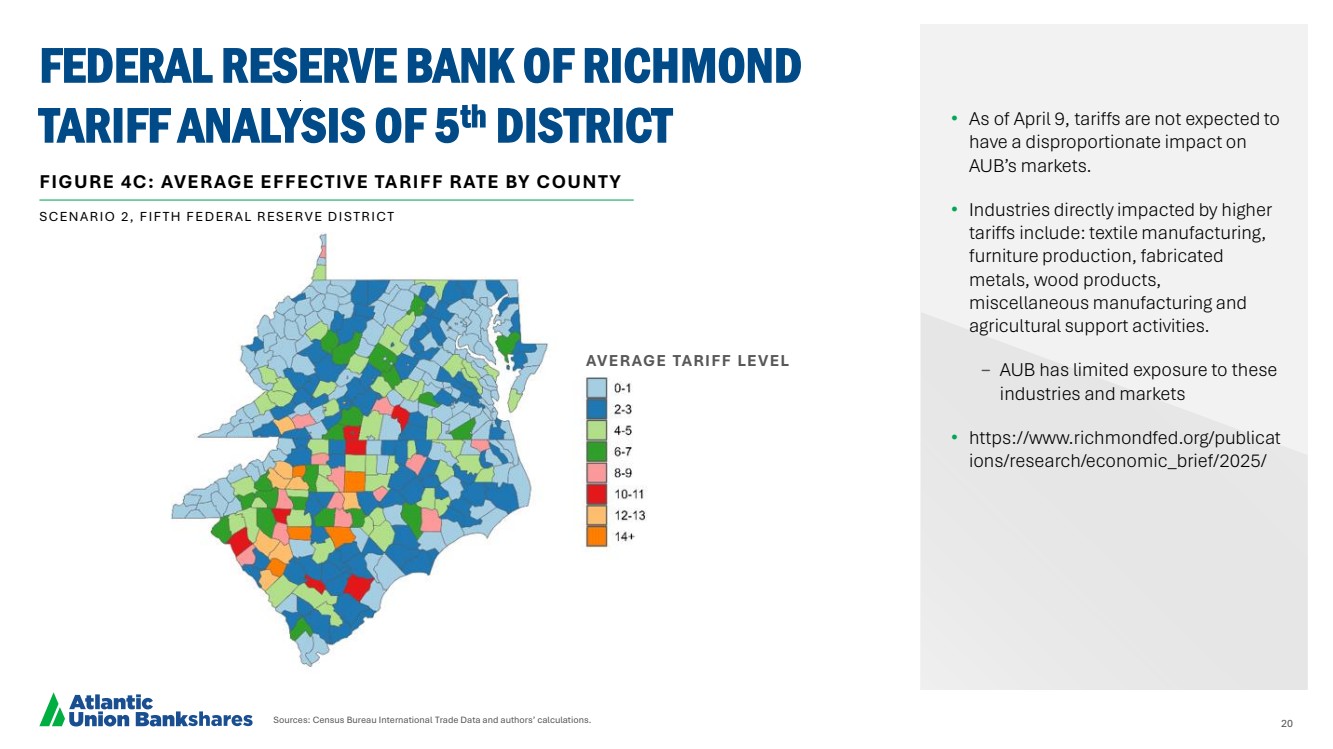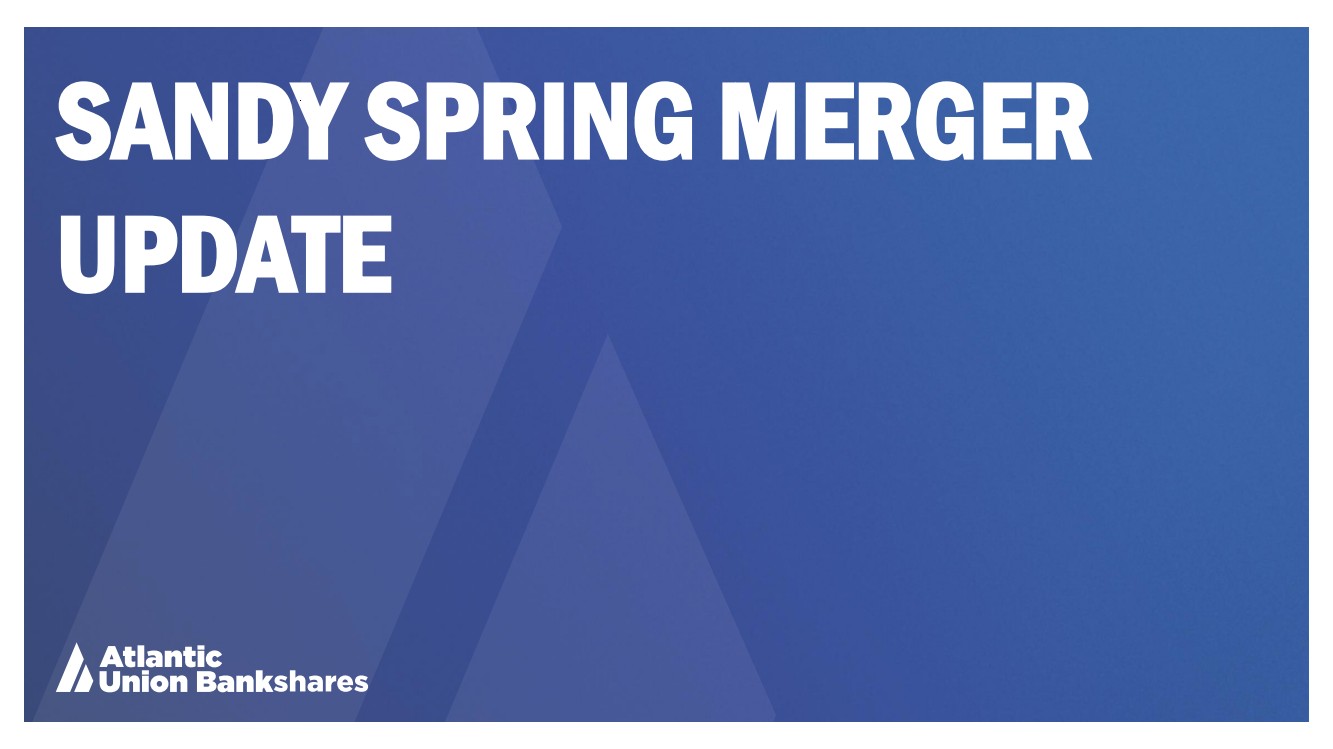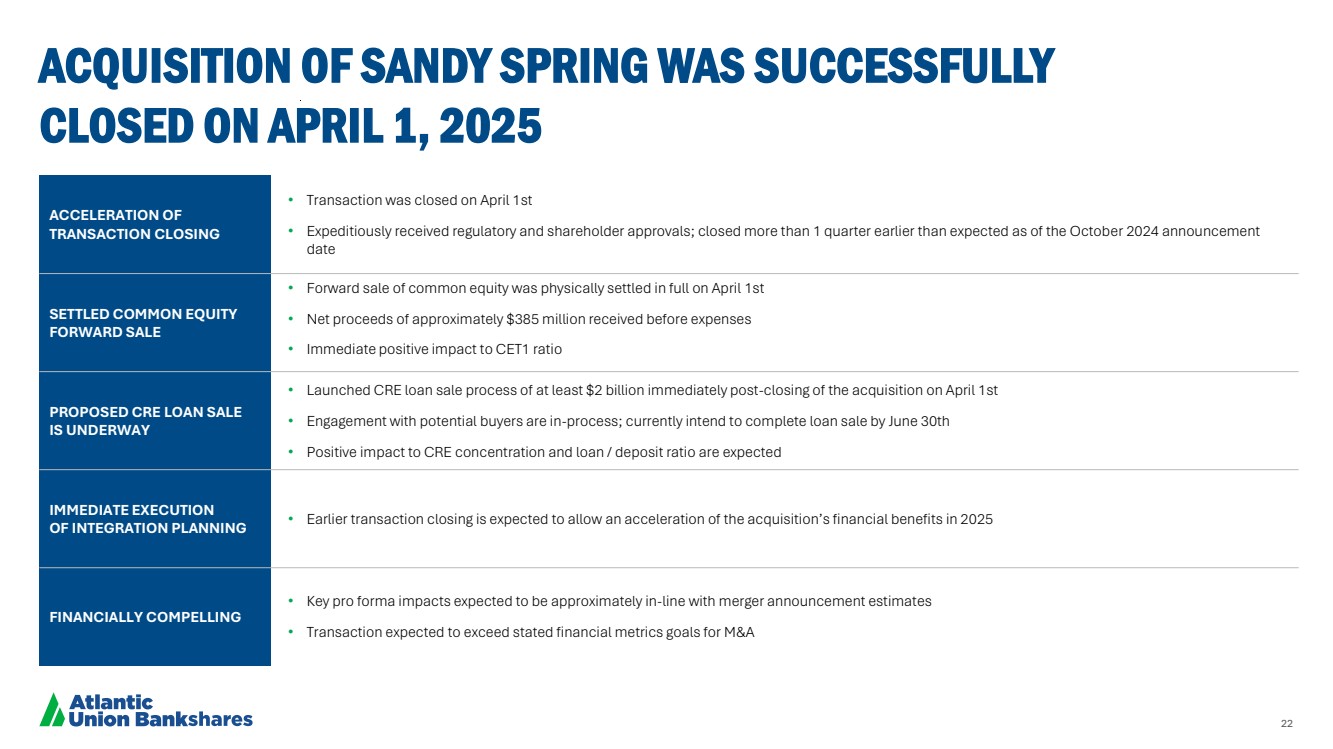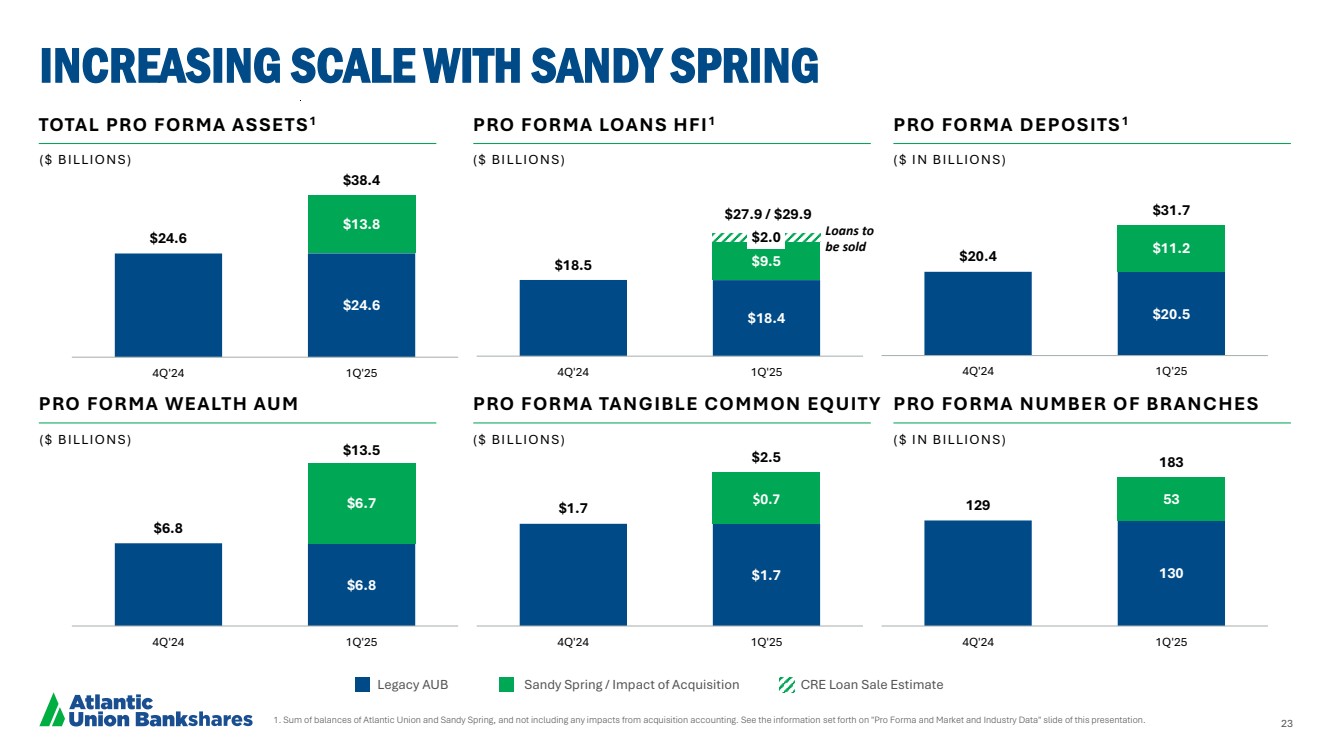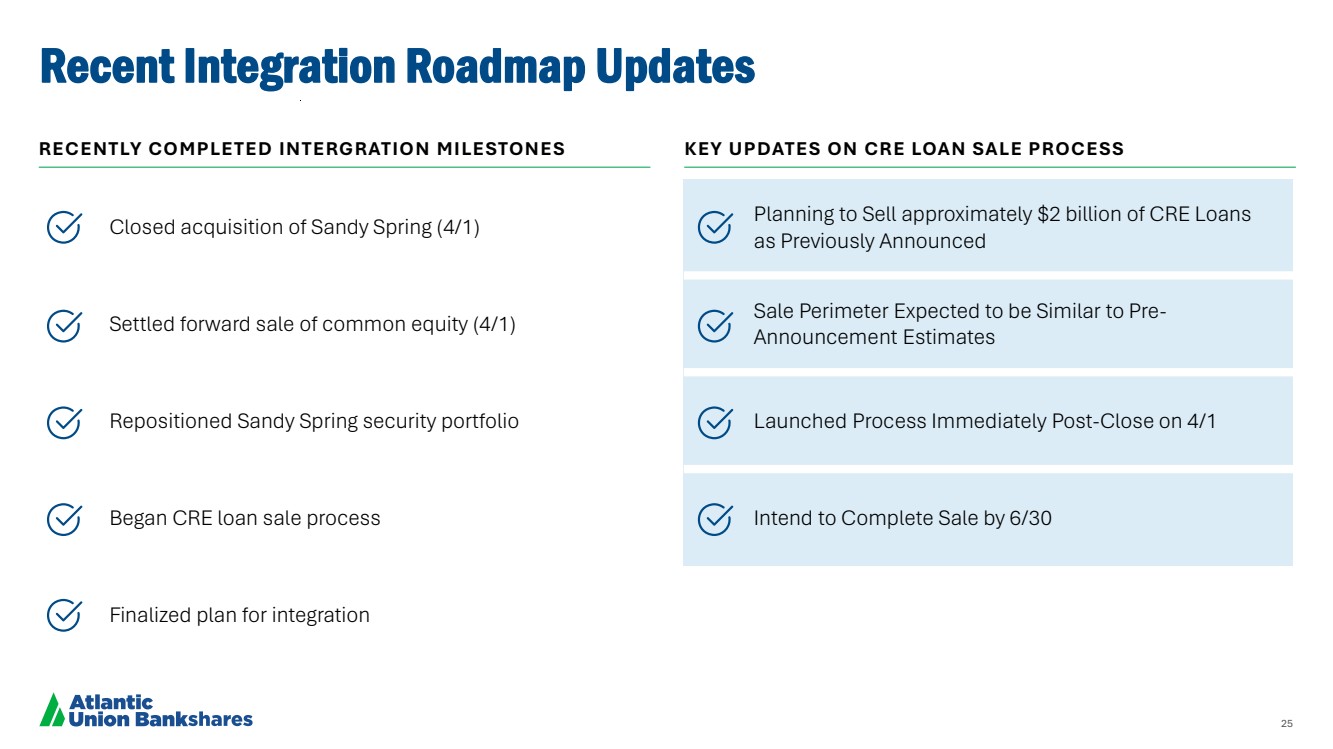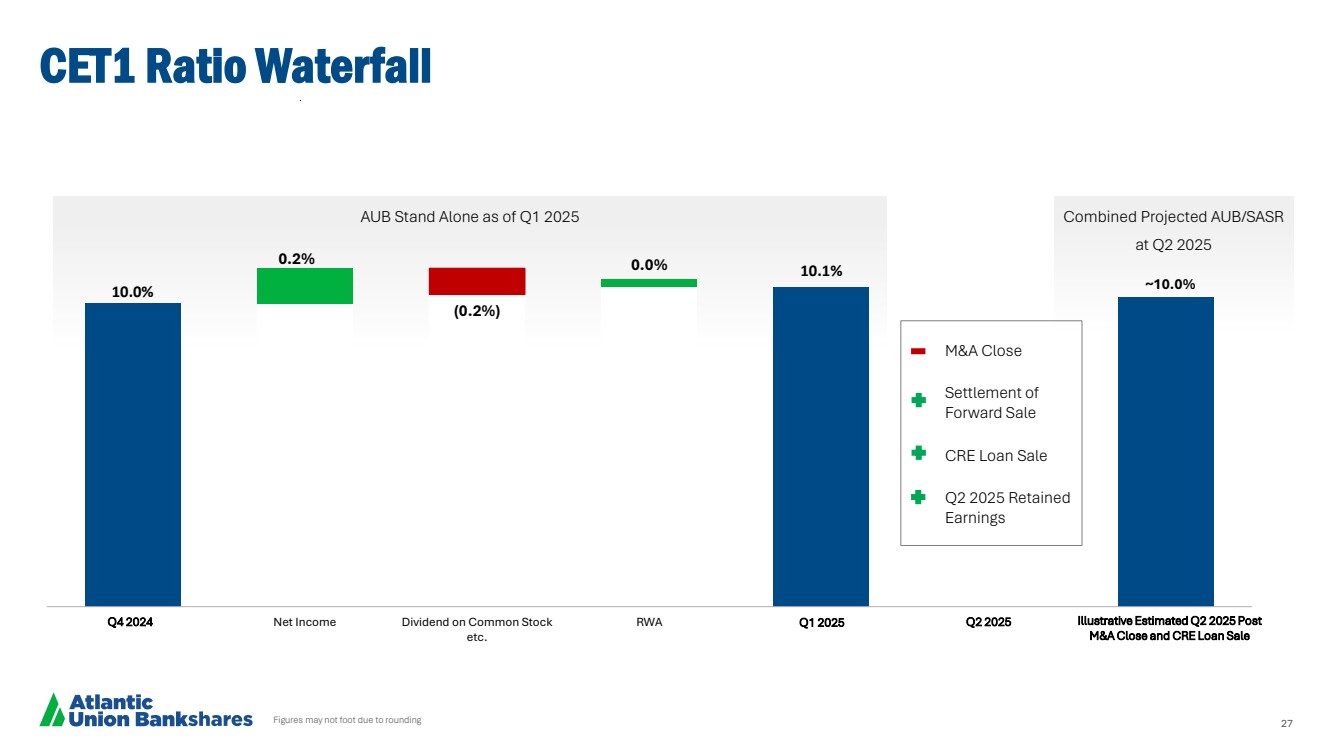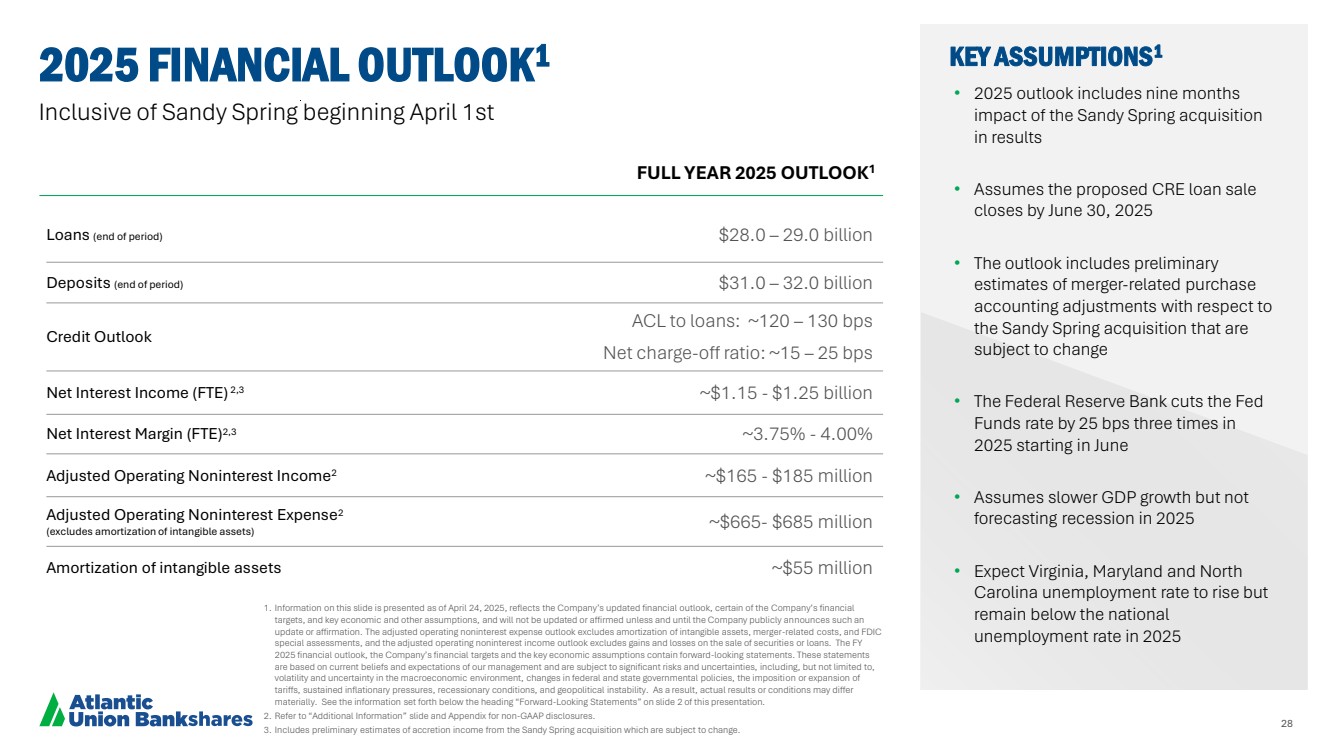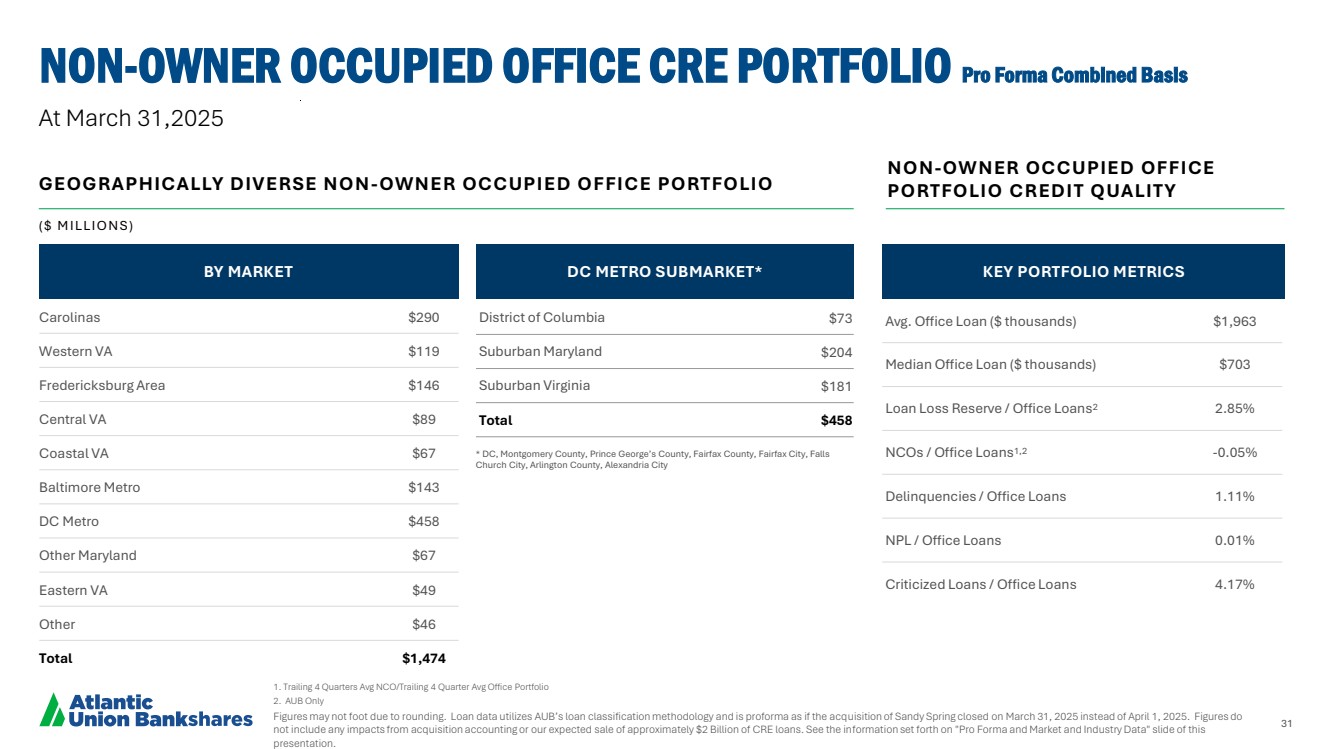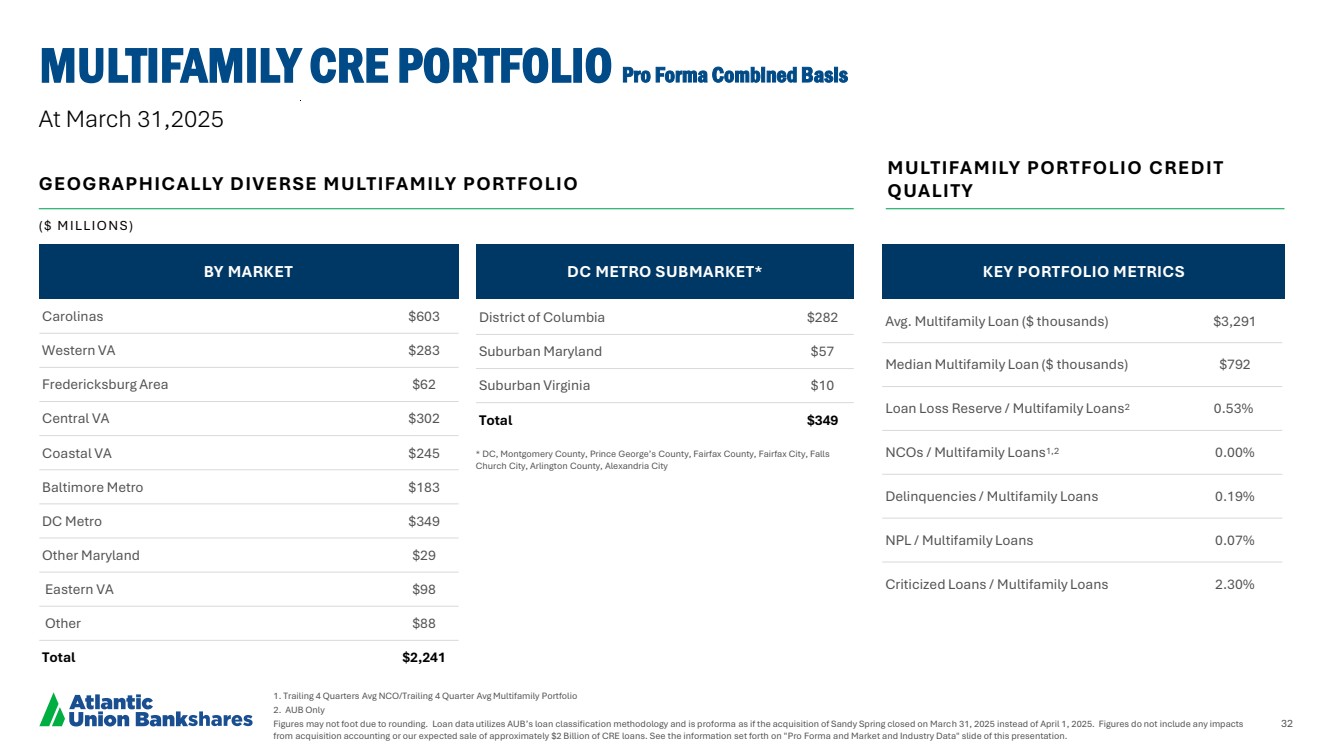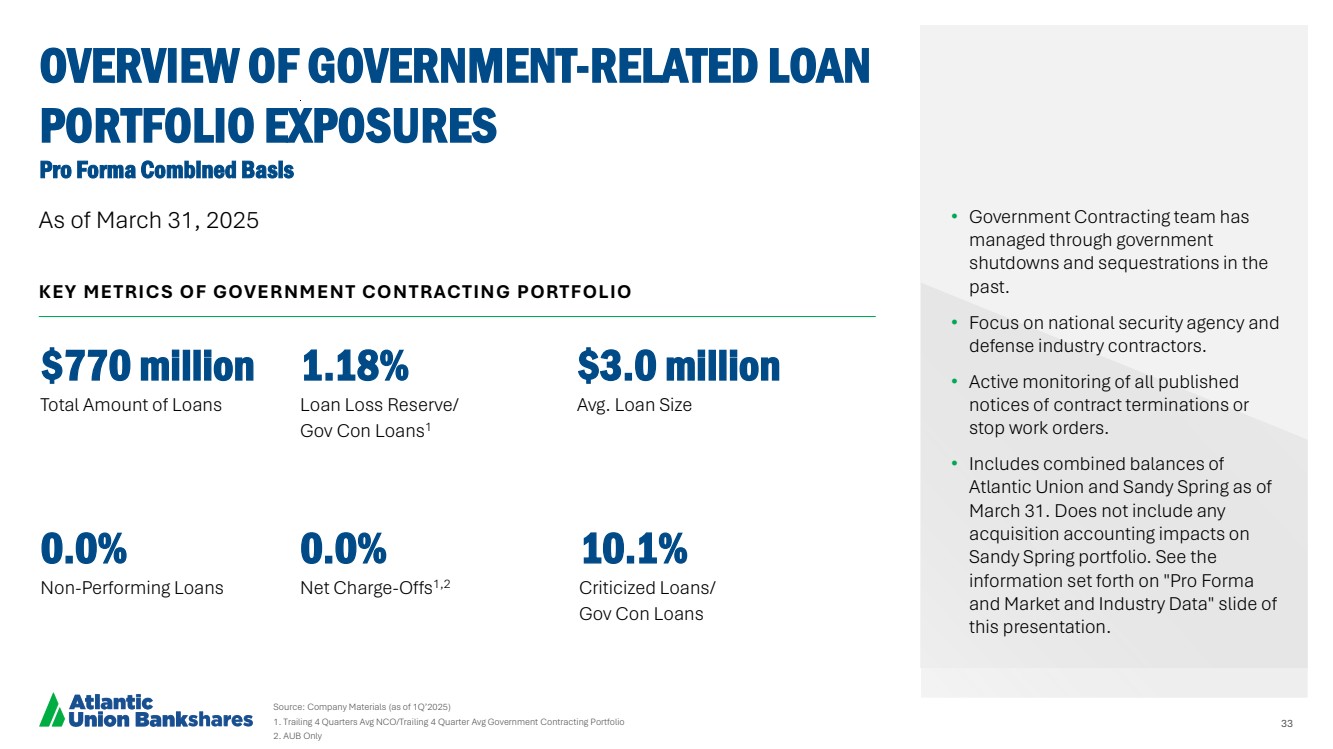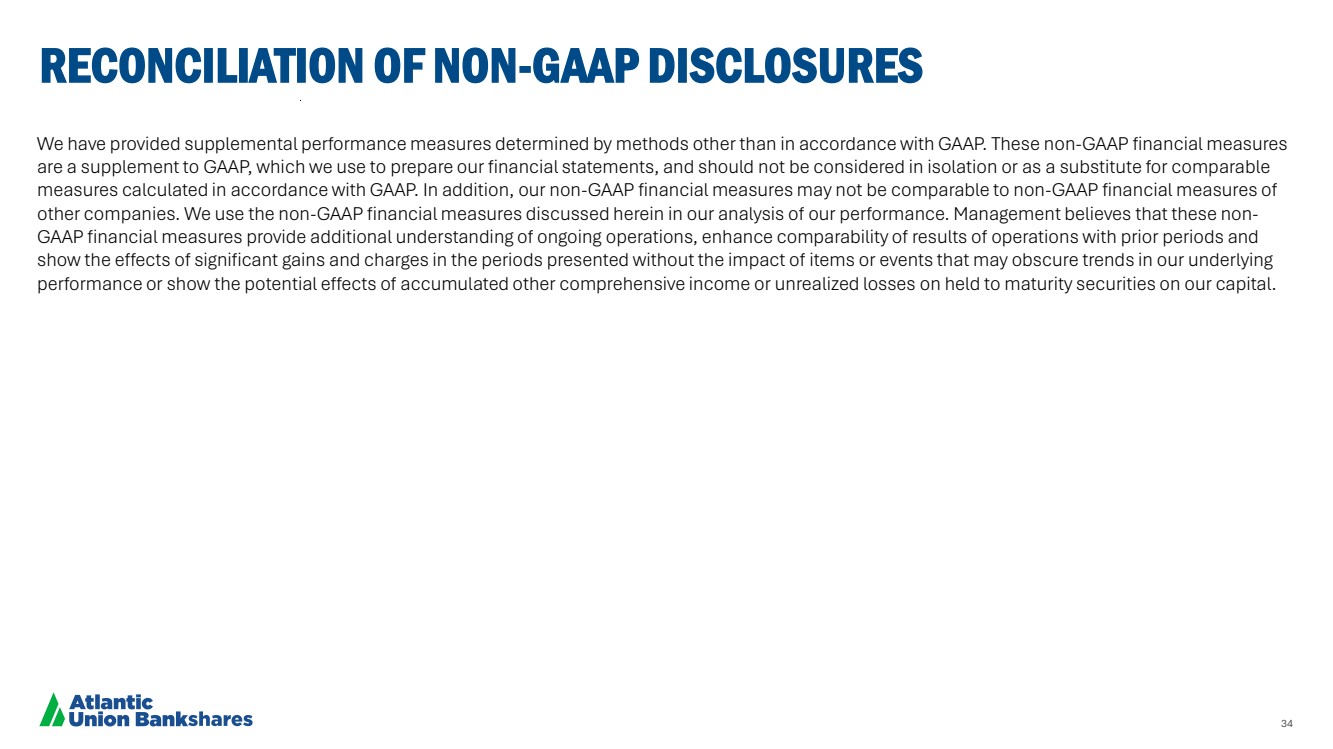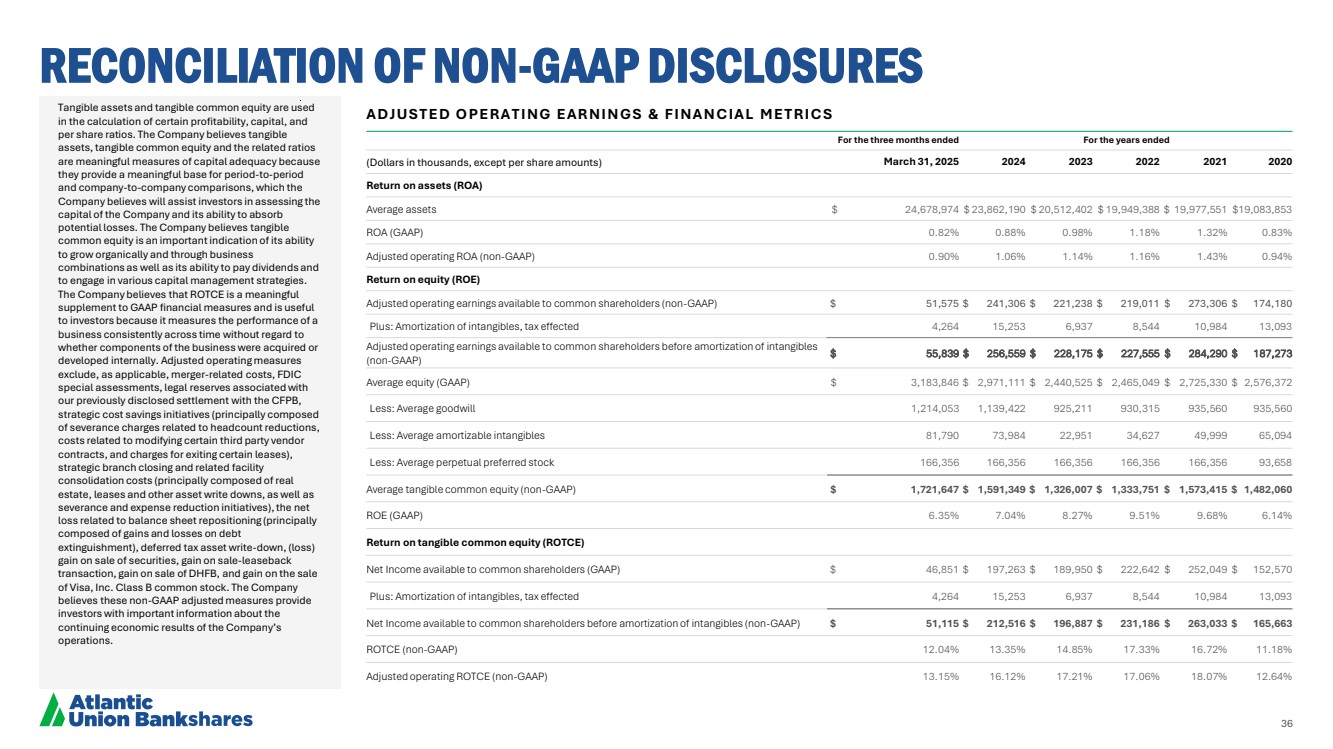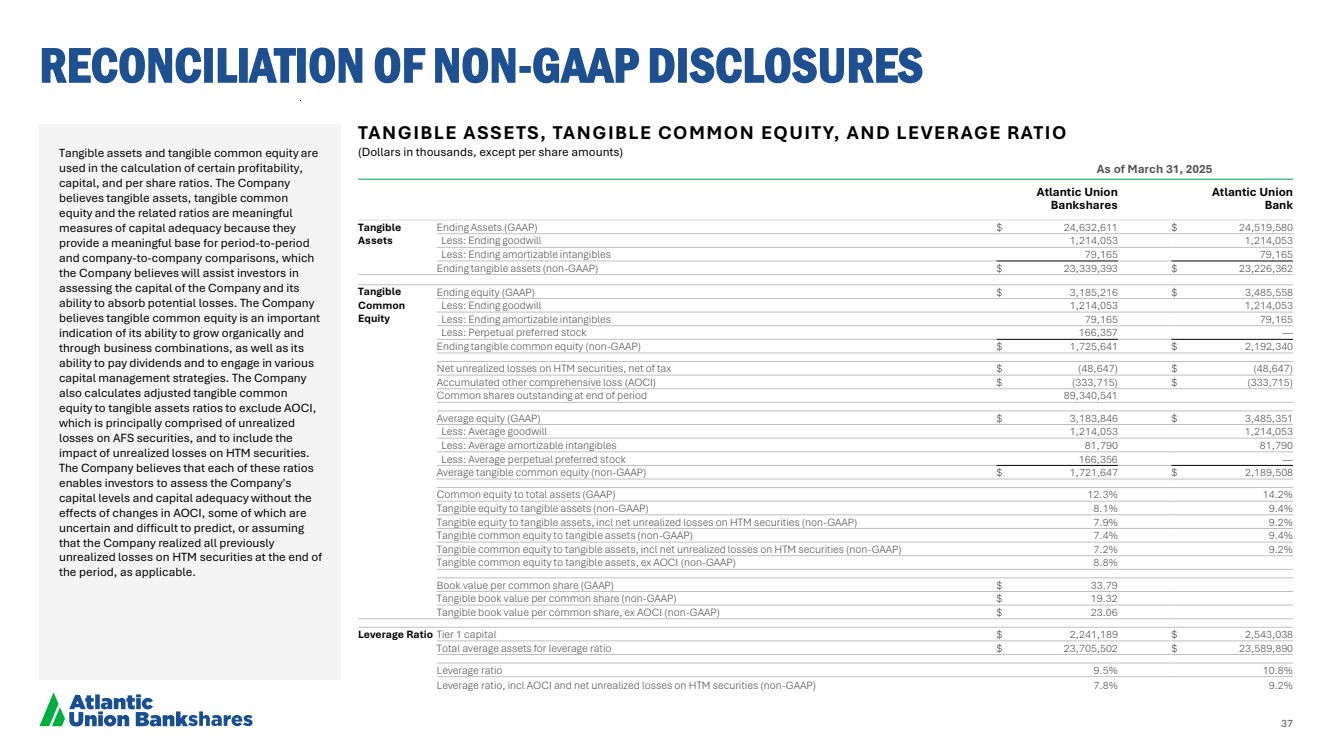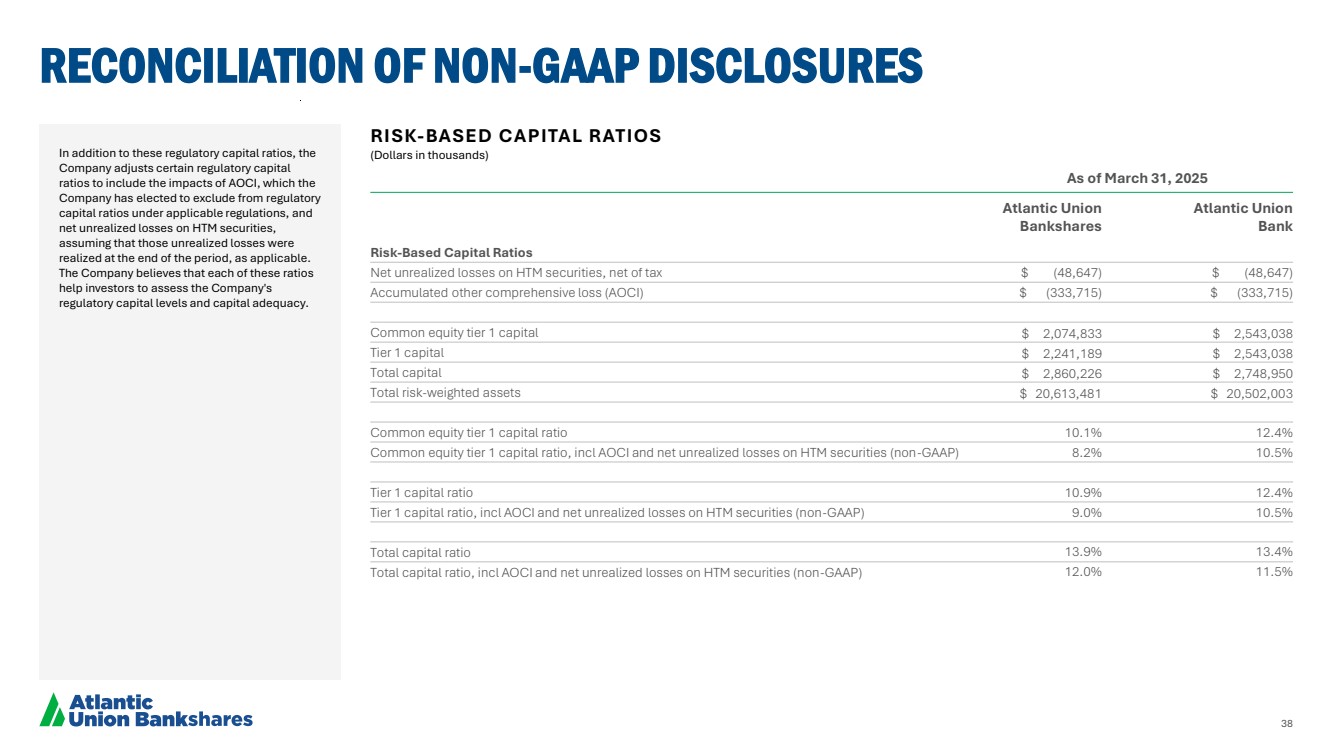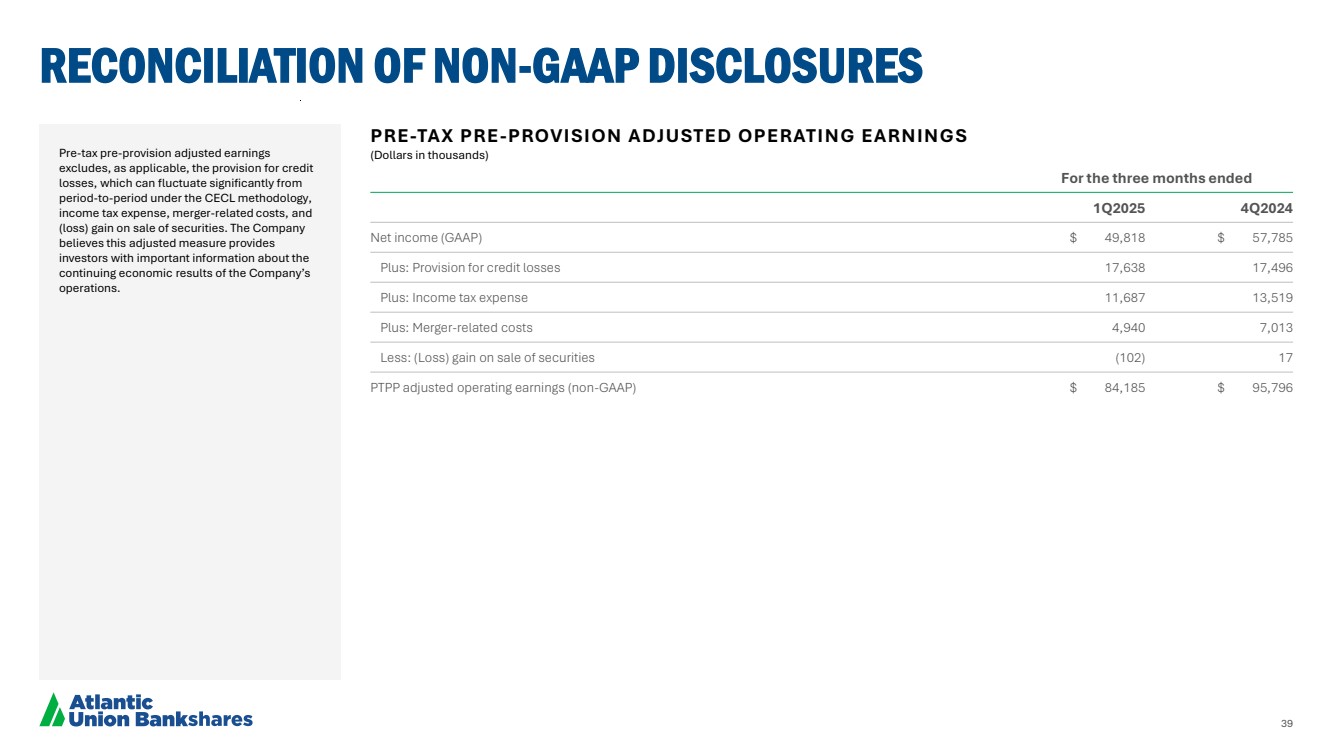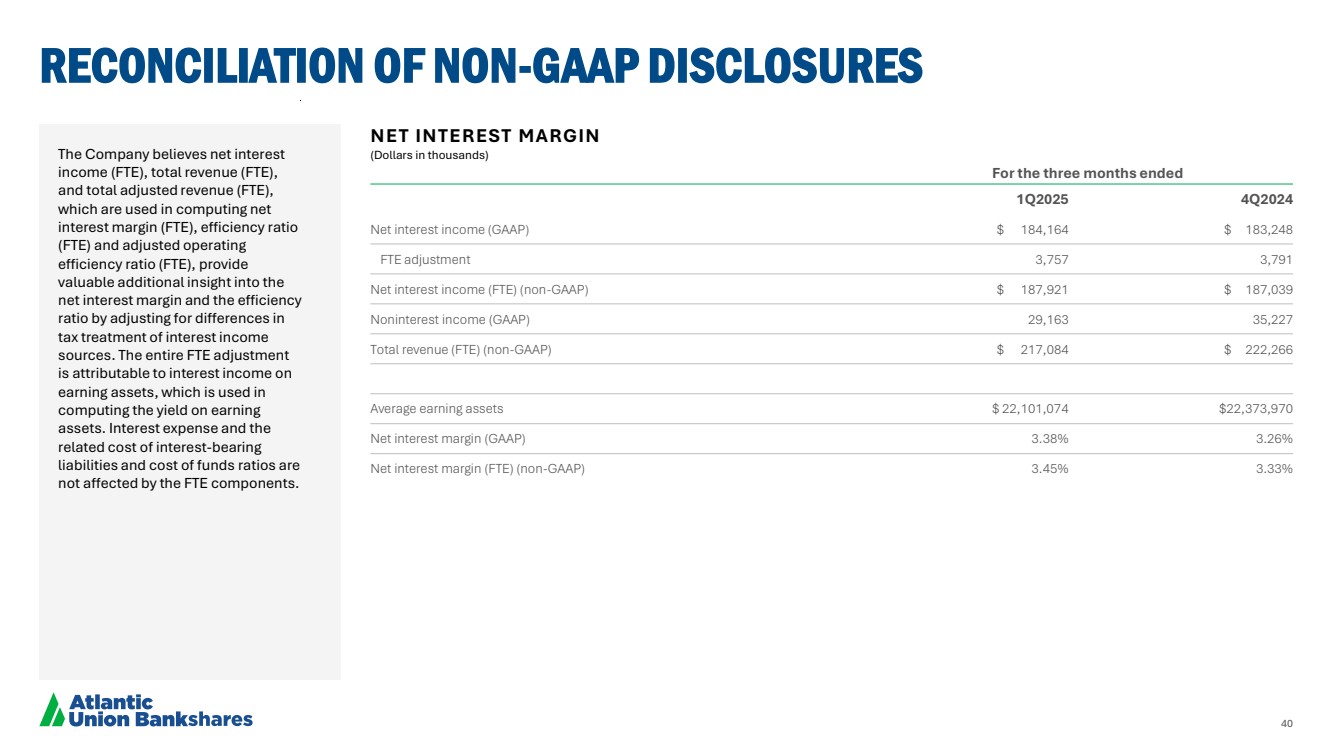| INVESTOR PRESENTATION NYSE: AUB MAY – JUNE 2025 |
| 2 FORWARD-LOOKING STATEMENTS This presentation and statements by our management may constitute “forward-looking statements” within the meaning of the Private Securities Litigation Reform Act of 1995. Forward-looking statements are statements that include, without limitation, statements regarding our recently completed acquisition of Sandy Spring Bancorp, Inc. (“Sandy Spring” or “SASR”) and expectations with regard to the benefits of the Sandy Spring acquisition, including anticipated accretion to earnings per share, the tangible book value earn-back period and other operating and return metrics; our business, financial and operating results, including our deposit base and funding; the impact of future economic conditions, anticipated changes in the interest rate environment and the related impacts on our net interest margin, changes in economic conditions; management’s beliefs regarding our liquidity, capital resources, asset quality, CRE loan portfolio and our customer relationships; statements that include other projections, predictions, expectations, or beliefs about future events or results or otherwise are not statements of historical fact, and statements on the slides entitled “We Are Focused on Three Strategic Priorities,” "Sizeable Opportunity to Take Market Share From the Big Three," "Market Opportunity in Maryland and North Carolina,“ “Financially Compelling Transaction,” and “2025 Financial Outlook (inclusive of Sandy Spring beginning April 1st)”. Such forward-looking statements are based on certain assumptions as of the time they are made, and are inherently subject to known and unknown risks, uncertainties, and other factors, some of which cannot be predicted or quantified, that may cause actual results, performance, or achievements to be materially different from those expressed or implied by such forward-looking statements. Forward-looking statements are often characterized by the use of qualified words (and their derivatives) such as “expect,” “believe,” “estimate,” “plan,” “project,” “anticipate,” “intend,” “will,” “may,” “view,” “opportunity,” “seek to,” “potential,” “continue,” “confidence,” or words of similar meaning or other statements concerning opinions or judgment of Atlantic Union Bankshares Corporation (the “Company,” “AUB,” “we,” “us” or “our”) and our management about future events. Although we believe that our expectations with respect to forward-looking statements are based on reasonable assumptions within the bounds of our existing knowledge of our business and operations, there can be no assurance that actual future results, performance, or achievements of, or trends affecting, us will not differ materially from any projected future results, performance, achievements or trends expressed or implied by such forward-looking statements. Actual future results, performance, achievements or trends may differ materially from historical results or those anticipated depending on a variety of factors, including, but not limited to, the effects of or changes in: • market interest rates and their related impacts on macroeconomic conditions, customer and client behavior, our funding costs and our loan and securities portfolios; • economic conditions, including inflation and recessionary conditions and their related impacts on economic growth and customer and client behavior; • U.S. and global trade policies and tensions, including change in, or the imposition of, tariffs and/or trade barriers and the economic impacts, volatility and uncertainty resulting therefrom, and geopolitical instability; • volatility in the financial services sector, including failures or rumors of failures of other depository institutions, including us, to attract and retain depositors and to borrow or raise capital; • legislative or regulatory changes and requirements, including as part of the regulatory reform agenda of the Trump administration, including changes in federal state or local tax laws and changes impacting the rulemaking, supervision, examination and enforcement priorities of the federal banking agencies; • the sufficiency of liquidity and changes in our capital position; • general economic and financial market conditions in the United States generally and particularly in the markets in which we operate and which our loans are concentrated, including the effects of declines in real estate values, an increase in unemployment levels, U.S. fiscal debt, budget and tax matters, and slowdowns in economic growth; • the diversion of management’s attention from ongoing business operations and opportunities due to our recent acquisition of Sandy Spring; • the impact of purchase accounting with respect to the Sandy Spring acquisition, or change in the assumptions used regarding the assets acquired and liabilities assumed to determine the fair value and credit marks; • the possibility that the anticipated benefits of our acquisition activity, including our acquisitions of Sandy Spring and American National Bankshares Inc. (“AMNB”), including anticipated cost savings and strategic gains, are not realized when expected or at all, including as a result of the strength of the economy, competitive factors in the areas where we do business, or as a result of other unexpected factors or events, or with respect to our acquisition of Sandy Spring, as a result of the impact of, or problems arising from, the integration of the two companies; • the integration of the business and operations of Sandy Spring may take longer or be more costly than anticipated; • potential adverse reactions or changes to business or employee relationships, including those resulting from our acquisitions of Sandy Spring and American National; • monetary, fiscal and regulatory policies of the U.S. government, including the U.S. Department of the Treasury and the Federal Reserve; • the quality or composition of our loan or investment portfolios and changes therein; • demand for loan products and financial services in our market areas; • our ability to manage our growth or implement our growth strategy; • the effectiveness of expense reduction plans; • the introduction of new lines of business or new products and services; • our ability to identify, recruit and retain key employees; • real estate values in our lending area; • changes in accounting principles, standards, rules, and interpretations, and the related impact on our financial statements; • an insufficient ACL or volatility in the ACL resulting from the CECL methodology, either alone or as that may be affected by changing economic conditions, credit concentrations, inflation, changing interest rates, or other factors; • concentrations of loans secured by real estate, particularly commercial real estate; • the effectiveness of our credit processes and management of our credit risk; • our ability to compete in the market for financial services and increased competition from fintech companies; • technological risks and developments, and cyber threats, attacks, or events; • operational, technological, cultural, regulatory, legal, credit, and other risks associated with the exploration, consummation and integration of potential future acquisitions, whether involving stock or cash consideration; • the potential adverse effects of unusual and infrequently occurring events, such as weather-related disasters, terrorist acts, geopolitical conflicts or public health events (such as pandemics), and of governmental and societal responses thereto; these potential adverse effects may include, without limitation, adverse effects on the ability of our borrowers to satisfy their obligations to us, on the value of collateral securing loans, on the demand for our loans or our other products and services, on supply chains and methods used to distribute products and services, on incidents of cyberattack and fraud, on our liquidity or capital positions, on risks posed by reliance on third-party service providers, on other aspects of our business operations and on financial markets and economic growth; • performance by our counterparties or vendors; • deposit flows; • the availability of financing and the terms thereof; • the level of prepayments on loans and mortgage-backed securities; • actual or potential claims, damages, and fines related to litigation or government actions, which may result in, among other things, additional costs, fines, penalties, restrictions on our business activities, reputational harm, or other adverse consequences; • any event or development that would cause us to conclude that there was an impairment of any asset, including intangible assets, such as goodwill; and • other factors, many of which are beyond our control. Please also refer to such other factors as discussed throughout Part I, Item 1A. “Risk Factors” and Part II, Item 7. “Management’s Discussion and Analysis of Financial Condition and Results of Operations” of our Annual Report on Form 10-K for the year ended December 31, 2024, and related disclosures in other filings, which have been filed with the U.S. Securities and Exchange Commission (“SEC”) and are available on the SEC’s website at www.sec.gov. All risk factors and uncertainties described herein and therein should be considered in evaluating forward-looking statements, and all forward-looking statements are expressly qualified by the cautionary statements contained or referred to herein and therein. The actual results or developments anticipated may not be realized or, even if substantially realized, they may not have the expected consequences to or effects on the Company or our businesses or operations. Readers are cautioned not to rely too heavily on the forward-looking statements. Forward-looking statements speak only as of the date they are made. We do not intend or assume any obligation to update, revise or clarify any forward-looking statements that may be made from time to time by or on behalf of the Company, whether because of new information, future events or otherwise, except as required by law. |
| 3 ADDITIONAL INFORMATION Non-GAAP Financial Measures This presentation contains certain financial information determined by methods other than in accordance with generally accepted accounting principles in the United States (“GAAP”). These non-GAAP financial measures are a supplement to GAAP, which is used to prepare our financial statements, and should not be considered in isolation or as a substitute for comparable measures calculated in accordance with GAAP. In addition, our non-GAAP financial measures may not be comparable to non-GAAP financial measures of other companies. We use the non-GAAP financial measures discussed herein in our analysis of our performance. Our management believes that these non-GAAP financial measures provide additional understanding of ongoing operations, enhance comparability of results of operations with prior periods, show the effects of significant gains and charges in the periods presented without the impact of items or events that may obscure trends in our underlying performance, or show the potential effects of accumulated other comprehensive income (or AOCI) or unrealized losses on securities on our capital. This presentation also includes certain projections of non-GAAP financial measures. Due to the inherent variability and difficulty associated with making accurate forecasts and projections of information that is excluded from these projected non-GAAP measures, and the fact that some of the excluded information is not currently ascertainable or accessible, we are unable to quantify certain amounts that would be required to be included in the most directly comparable projected GAAP financial measures without unreasonable effort. Consequently, no disclosure of projected comparable GAAP measures is included, and no reconciliation of forward-looking non-GAAP financial information is included. Please see “Reconciliation of Non-GAAP Disclosures” at the end of this presentation for a reconciliation to the nearest GAAP financial measure. No Offer or Solicitation This presentation does not constitute an offer to sell or a solicitation of an offer to buy any securities. No offer of securities shall be made except by means of a prospectus meeting the requirements of the Securities Act of 1933, as amended, and no offer to sell or solicitation of an offer to buy shall be made in any jurisdiction in which such offer, solicitation or sale would be unlawful. About Atlantic Union Bankshares Corporation Headquartered in Richmond, Virginia, Atlantic Union Bankshares Corporation (NYSE: AUB) is the holding company for Atlantic Union Bank. Atlantic Union Bank has branches and ATMs located throughout Virginia and in portions of Maryland and North Carolina. Certain non-bank financial services affiliates of Atlantic Union Bank include: Atlantic Union Equipment Finance, Inc., which provides equipment financing; Atlantic Union Financial Consultants, LLC, which provides brokerage services; and Union Insurance Group, LLC, which offers various lines of insurance products. |
| 4 PRO FORMA AND MARKET AND INDUSTRY DATA Pro Forma Data Neither Atlantic Union’s nor Sandy Spring’s independent registered public accounting firms have studied, reviewed or performed any procedures with respect to the pro forma or pro forma forward-looking financial data for the purpose of inclusion in this presentation, and, accordingly, neither have expressed an opinion or provided any form of assurance with respect thereto for the purpose of this presentation. The pro forma combined data of Atlantic Union and Sandy Spring is as of March 31, 2025, and is based on the GAAP results of Atlantic Union and Sandy Spring for the applicable periods without adjustments, except where specifically noted. The pro forma combined data included in this presentation does not reflect any purchase accounting adjustments. All pro forma data should be reviewed in connection with the historical information of Atlantic Union and Sandy Spring, as applicable. These pro forma and pro forma forward-looking financial data are for illustrative purposes only and should not be relied on as necessarily being indicative of future results. The assumptions and estimates underlying the pro forma and pro forma forward-looking financial data are inherently uncertain and are subject to a wide variety of significant business, economic and competitive risks and uncertainties that could cause actual results to differ materially from those contained in the prospective financial information, including those in the “Forward-Looking Statements” disclaimer on slide 2 of this presentation. Pro forma and pro forma forward-looking financial data is inherently uncertain due to a number of factors outside of Atlantic Union’s and Sandy Spring’s control. Accordingly, there can be no assurance that the pro forma combined information, pro forma forward-looking financial data or prospective results are indicative of future performance of the combined company after the acquisition of Sandy Spring that consummated on April 1, 2025 or that actual results will not differ materially from those presented in the pro forma and pro forma forward-looking financial data. Inclusion of pro forma and pro forma financial data in this presentation should not be regarded as a representation by any person that the results contained in the prospective financial information will be achieved. Further, neither the pro forma nor the pro forma forward-looking financial data has been prepared in accordance with Article 11 of Regulation S-X, and, therefore, does not reflect any of the adjustments that would be required thereby. Market and Industry Data Unless otherwise indicated, market data and certain industry forecast data used in this presentation were obtained from internal reports, where appropriate, as well as third party sources and other publicly available information. Data regarding the industries in which the Company competes, its market position and market share within these industries are inherently imprecise and are subject to significant business, economic and competitive uncertainties beyond the Company's control. In addition, assumptions and estimates of the Company and its industries' future performance are necessarily subject to a high degree of uncertainty and risk due to a variety of factors. These and other factors could cause future performance to differ materially from assumptions and estimates. |
| 5 N O R F O L K V I R G I N I A B E A C H M a ry l a n d V irg in ia No rth C a ro l in a C H A R L O T T E W I L M I N G T O N B A L T I M O R E R A L E I G H G R E E N S B O R O W A S H I N G T O N R O A N O K E S T A U N T O N C H A R L O T T E S V I L L E R I C H M O N D F R E D E R I C K S B U R G HIGHLIGHTS1 branches across Virginia, North Carolina and Maryland footprint 183 largest regional bank in Mid-Atlantic, Maryland and Virginia2,3 #1 $38 Billion Assets $30 Billion Loans $32 Billion Deposits $4.4 Billion Market Capitalization Soundness | Profitability | Growth 1. Assets, Loans, Deposits and Branch Count are proforma as if the acquisition of Sandy Spring closed on March 31, 2025 instead of April 1, 2025 and do not include any impacts from acquisition accounting or our expected sale of approximately $2 billion of commercial real estate (“CRE”) loans, Market Cap is as of May 12, 2025. 2. See the information set forth on "Pro Forma and Market and Industry Data" slide of this presentation. 3. Regional market: Delaware, Maryland, New Jersey, Pennsylvania, Virginia, Washington D.C., and West Virginia 4. Regional banks defined as U.S. Banks with <$100 Billion in assets OUR COMPANY Pro Forma Combined Basis Branch (183) LPO (2) Largest Regional Bank Headquartered in the Lower Mid-Atlantic |
| 6 Dense, uniquely valuable presence across attractive markets FINANCIAL STRENGTH Solid balance sheet & capital levels PEER-LEADING PERFORMANCE Committed to top-tier financial performance ATTRACTIVE FINANCIAL PROFILE Solid dividend yield & payout ratio with earnings upside STRONG GROWTH POTENTIAL Organic & acquisition opportunities OUR SHAREHOLDER VALUE PROPOSITION Positioned for growth and long-term shareholder value creation as a preeminent regional bank with a leading presence in attractive markets LEADING REGIONAL PRESENCE |
| 7 CARING Working together toward common goals, acting with kindness, respect and a genuine concern for others. COURAGEOUS Speaking openly, honestly and accepting our challenges and mistakes as opportunities to learn and grow. COMMITTED Driven to help our clients, Teammates and company succeed, doing what is right and accountable for our actions. Culture — HOW we come together and interact as a team to accomplish our business and societal goals. OUR CORE VALUES Culture — HOW we come together and interact as a team to accomplish our business and societal goals. |
| 8 WE ARE FOCUSED ON THREE STRATEGIC PRIORITIES ORGANIC DELIVER ORGANIC GROWTH • Overweighting opportunities in Wholesale Banking Group • Directing consumer efforts to market segments and delivery channels with the strongest value proposition • Prioritizing fee income growth • Maintaining a reliable low-cost deposit base • Maximizing operating leverage, productivity, efficiency, and scale • Attracting and retaining top talent in alignment with broader business goals and strategic priorities STRATEGIC INVESTMENTS • Leverage FinTech partnerships, strategic partner equity investments, as well as non-bank and whole-bank acquisition opportunities for step-change accelerants of growth • Acquisition philosophy remains: strategic, disciplined, and measured with an eye towards transactions that increase density and scarcity value, add contiguous markets, increase operating leverage, diversify revenue streams, and enable the reinvestment of cost savings into technology • Ensuring merger and acquisition activity complements, enables, and scales technology and the advancement of our customer value proposition, potentially including whole bank, non-bank, minority stakes, and partnerships INNOVATE AND TRANSFORM • Pressing the relationship model advantage where bankers provide advocacy and advice, form stickier relationships, and use technology to enable deeper relationships • Creating a frictionless experience for customers by integrating human interactions with digital capabilities • Eliminating low value tasks and enabling more high value interactions with customers • Eliminating legacy system constraints and accelerating modernization of technology while rationalizing operating costs and reengineering processes • Emphasizing robotics, automation and FinTech partnerships INORGANIC |
| 1. For non-GAAP financial measures, see reconciliation to most directly comparable GAAP measure in "Appendix - Reconciliation of Non-GAAP Disclosures” 9 HIGHLIGHTS Q1 2025 LOAN & DEPOSIT GROWTH Average loan growth of approximately 1.3% annualized for Q1 2025 Deposit growth of approximately 2.1% annualized for Q1 2025 with demand deposits increasing $194 million while reducing brokered deposit by approximately $109 million Loan/Deposit ratio of 89.9% at March 31, 2025 POSITIONING FOR LONG TERM Lending pipelines remain healthy Focus on integration of Sandy Spring, performance of the core banking franchise, and building out North Carolina teams Disciplined expense management DIFFERENTIATED CLIENT EXPERIENCE Responsive, strong and capable alternative to large national banks, while competitive with and more capable than smaller banks CAPITALIZE ON STRATEGIC OPPORTUNITIES Closed the acquisition of Sandy Spring on April 1, 2025 Sandy Spring core systems conversion scheduled for October 2025 FINANCIAL RATIOS Q1 2025 adjusted operating return on tangible common equity of 13.2%1 Q1 2025 adjusted operating return on assets of 0.90%1 Q1 2025 adjusted operating efficiency ratio (FTE) of 57.02%1 Q1 2025 pre-tax pre-provision adjusted operating earnings of $84.2 million1 ASSET QUALITY Q1 2025 net charge-offs at 5 bps annualized Increased Allowance for Credit Loss to 1.13% of loans held for investment primarily reflecting the impacts of the increased uncertainty in the economic outlook 9 |
| 10 LOANS ($mm) $15,723 $16,611 $15,932 $16,818 $20,398 $20,503 2020 2021 2022 2023 2024 1Q 2025 Data as of December 31 each respective year, except for 1Q 2025 which is as of March 31, 2025 CAGR defined as compounded annual growth rate from 2020 through 1Q 2025 BALANCE SHEET TRENDS (GAAP) $19,628 $20,065 $20,461 $21,166 $24,585 $24,633 2020 2021 2022 2023 2024 1Q 2025 $14,021 $13,196 $14,449 $15,635 $18,471 $18,428 2020 2021 2022 2023 2024 1Q 2025 7% CAGR DEPOSITS ($mm) 6% CAGR ASSETS ($mm) 5% CAGR |
| 11 Data as of or for the twelve months ended each respective year, except for 1Q 2025 which is for the three months ended March 31, 2025 STRONG TRACK RECORD OF PERFORMANCE (GAAP) $1.93 $3.26 $2.97 $2.53 $2.24 $0.52 2020 2021 2022 2023 2024 Q1 2025 6.14% 9.68% 9.51% 8.27% 7.04% 6.35% 2020 2021 2022 2023 2024 1Q 2025 60.19% 61.91% 57.46% 61.32% 62.09% 62.90% 2020 2021 2022 2023 2024 1Q 2025 0.83% 1.32% 1.18% 0.98% 0.88% 0.82% 2020 2021 2022 2023 2024 1Q 2025 EARNINGS PER SHARE, DILUTED AVAILABLE TO COMMON SHAREHOLDERS ($) RETURN ON EQUITY (ROE) (%) RETURN ON ASSETS (ROA) (%) EFFICIENCY RATIO (%) |
| 12 STRONG TRACK RECORD OF PERFORMANCE (NON-GAAP) Data as of or for the twelve months ended each respective year, except for 1Q 2025 which is for the three months ended March 31, 2025 (1) Non-GAAP financial measure; See reconciliation to most directly comparable GAAP measure in "Appendix -- Reconciliation of Non-GAAP Disclosures” ADJUSTED OPERATING EARNINGS PER SHARE AVAILABLE TO COMMON SHAREHOLDERS, DILUTED ($)(1) ADJUSTED OPERATING RETURN ON TANGIBLE COMMON EQUITY (ROTCE) (%)(1) ADJUSTED OPERATING RETURN ON ASSETS (ROA) (%)(1) ADJUSTED OPERATING EFFICIENCY RATIO (FTE) (%)(1) $2.21 $3.53 $2.92 $2.95 $2.74 $0.57 2020 2021 2022 2023 2024* 1Q 2025 12.64% 18.07% 17.06% 17.21% 16.12% 13.15% 2020 2021 2022 2023 2024* 1Q 2025 52.18% 54.52% 54.68% 54.15% 53.31% 57.02% 2020 2021 2022 2023 2024 1Q 2025 0.94% 1.43% 1.16% 1.14% 1.06% 0.90% 2020 2021 2022 2023 2024* 1Q 2025 * Includes (0.57%) of initial provision expense related to the AMNB acquisition, comprised of the initial provision expense on non-PCD loans, which represents the CECL “double count” of the non-PCD credit mark, and the additional provision for unfunded commitments * Includes ($0.14) of initial provision expense related to the AMNB acquisition, comprised of the initial provision expense on non-PCD loans, which represents the CECL “double count” of the non-PCD credit mark, and the additional provision for unfunded commitments * Includes (0.05%) of initial provision expense related to the AMNB acquisition, comprised of the initial provision expense on non-PCD loans, which represents the CECL “double count” of the non-PCD credit mark, and the additional provision for unfunded commitments |
| 13 CAPITAL RATIO REGULATORY WELL CAPITALIZED MINIMUMS REPORTED PRO FORMA INCLUDING AOCI & HTM UNREALIZED LOSSES ATLANTIC UNION BANKSHARES ATLANTIC UNION BANK ATLANTIC UNION BANKSHARES ATLANTIC UNION BANK Common Equity Tier 1 Ratio (CET1) 6.5% 10.1% 12.4% 8.2% 10.5% Tier 1 Capital Ratio 8.0% 10.9% 12.4% 9.0% 10.5% Total Risk Based Capital Ratio 10.0% 13.9% 13.4% 12.0% 11.5% Leverage Ratio 5.0% 9.5% 10.8% 7.8% 9.2% Tangible Equity to Tangible Assets (non-GAAP)1 -- 8.1% 9.4% 7.9% 9.2% Tangible Common Equity Ratio (non-GAAP) 1 -- 7.4% 9.4% 7.2% 9.2% 1. For non-GAAP financial measures, see reconciliation to most directly comparable GAAP measures in “Appendix – Reconciliation of Non-GAAP Disclosures” * Capital information presented herein is based on estimates and subject to change pending the Company’s filing of its regulatory reports STRONG CAPITAL POSITION CAPITAL MANAGEMENT STRATEGY ATLANTIC UNION CAPITAL MANAGEMENT OBJECTIVES ARE TO: • Maintain designation as a “well capitalized” institution. • Ensure capital levels are commensurate with the Company’s risk profile, capital stress test projections, and strategic plan objectives. THE COMPANY’S CAPITAL RATIOS ARE WELL ABOVE REGULATORY WELL CAPITALIZED LEVELS AS OF MARCH 31, 2025 • On a pro forma standalone basis, the Company would be well capitalized if unrealized losses on securities were realized at March 31, 2025. CAPITAL MANAGEMENT ACTIONS • During the first quarter, the Company paid a common stock dividend of 34 cents per share, which was an increase of 6.3% from the first quarter of 2024 dividend amount. • During the first quarter of 2025, the Company paid dividends of $171.88 per outstanding share of Series A Preferred Stock At March 31, 2025 |
| Including Sandy Spring franchise footprint AUB FRANCHISE PERSPECTIVES |
| 15 VIRGINIA NORTH CAROLINA CHARLOTTE WILMINGTON MARYLAND Atlantic Union: 130 Branches Atlantic Union: 2 LPOs Sandy Spring: 53 Branches #1 Largest Regional Bank in Mid-Atlantic1,2 22 Pro Forma MSAs of Operation #1 Largest Regional Bank in Virginia2 #1 Largest Regional Bank in Maryland2 183 Pro Forma Branches $38.4 billion Pro Forma Assets Source: SNL Financial Data, Branch count, assets, loans and deposits proforma as if the acquisition closed on March 31 instead of April 1 and do not include any impacts from acquisition accounting or our expected sale of $2 billion of CRE loans. Market share as of September 2024 FDIC depository data with a deposit cap of $5B per branch, See the information set forth on "Pro Forma and Market and Industry Data" slide of this presentation. 1. Regional market: Delaware, Maryland, New Jersey, Pennsylvania, Virginia, Washington D.C., and West Virginia 2. Regional banks defined as U.S. Banks with <$100 billion in assets SUMMARY OF ATLANTIC UNION’S MID-ATLANTIC PRESENCE Pro Forma Combined ATTRACTIVE MARKET PRESENCE1 $31.7 billion Pro Forma Deposits $29.9 billion Pro Forma Loans |
| 16 Source: SNL Financial and FDIC deposit data Deposit and branch data as of 6/30/24 which are both presented on a pro forma basis for any announced transactions , and, with respect to Atlantic Union, includes the pro forma impact of our acquisition of Sandy Spring excluding any impacts from acquisition accounting Note: Excludes branches with deposits greater than $5.0 billion VIRGINIA: ALL BANKS VIRGINIA: BANKS HEADQUARTERED IN VA Rank Institution Deposits ($mm) Market Share (%) Branches 1 Truist Financial Corp $48,427 21.3% 260 2 Wells Fargo & Co 32,756 14.4 185 3 Bank of America Corp. 25,539 11.3 101 4 Atlantic Union Bankshares Corp 20,678 9.1 130 5 TowneBank 12,554 5.5 61 6 United Bankshares Inc. 9,057 4.0 80 7 PNC Financial Services Group Inc. 5,031 2.2 57 8 Capital One Financial Corp. 5,014 2.2 20 9 Burke & Herbert 3,797 1.7 37 10 Carter Bank & Trust 3,334 1.5 53 Top 10 Banks $166,186 73.2% 984 All Institutions in Market $226,917 100.0% 1,853 Rank Institution Deposits ($mm) Market Share (%) Branches 1 Atlantic Union Bankshares Corp. $20,678 24.3% 130 2 TowneBank 12,554 14.7 61 3 Capital One Financial Corp. 5,014 5.9 20 4 Burke & Herbert 3,797 4.5 37 5 Carter Bank & Trust 3,334 3.9 53 6 Primis Financial Corp 3,173 3.7 25 7 First Bancorp Inc. 2,685 3.2 20 8 Blue Ridge Bankshares Inc. 2,354 2.8 30 9 C&F Financial Corp 2,118 2.5 31 10 FVCBankcorp Inc. 1,861 2.2 5 Top 10 Banks $57,567 67.6% 412 All Institutions in Market $85,196 100.0% 834 Statewide Branch Footprint Brings Unique Franchise Value and Significant Growth Opportunity SIZEABLE OPPORTUNITY TO TAKE MARKET SHARE FROM THE BIG THREE Franchise Strength Growth Opportunity |
| 17 Growth Opportunity in both Maryland and North Carolina Source: SNL Financial and FDIC deposit data Deposit and branch data as of 6/30/24 which is presented on a pro forma basis for any announced transactions, and, with respect to Atlantic Union, includes the pro forma impact of our acquisition of Sandy Spring excluding any impacts from acquisition accounting Note: Excludes branches with deposits greater than $5.0 billion MARKET OPPORTUNITY IN MARYLAND AND NORTH CAROLINA MARYLAND: ALL BANKS NORTH CAROLINA: ALL BANKS Rank Institution Deposits ($mm) Market Share (%) Branches 1 Truist Financial Corp. $43,459 19.5% 275 2 Wells Fargo & Co. 37,836 17.0 229 3 First Citizens BancShares Inc. 25,019 11.2 200 4 Bank of America Corp. 20,970 9.4 106 5 PNC Financial Services Group Inc. 10,335 4.6 104 6 First Bancorp 9,152 4.1 101 7 Fifth Third Bancorp 7,702 3.5 77 8 F.N.B. Corp. 7,636 3.4 91 9 First Horizon Corp. 6,832 3.1 79 10 Pinnacle Financial Partners Inc. 6,504 2.9 48 26 Atlantic Union Bankshares Corp. 1,036 0.5 11 Top 10 Banks $175,445 78.7% 1,310 All Institutions in Market $222,801 100.0% 1,995 Rank Institution Deposits ($mm) Market Share (%) Branches 1 Bank of America Corp. $30,444 17.6% 118 2 Truist Financial Corp. 21,651 12.5 138 3 M&T Bank Corp. 18,295 10.6 160 4 PNC Financial Services Group Inc. 17,273 10.0 117 5 Wells Fargo & Co. 11,695 6.8 75 6 Capital One Financial Corp. 11,342 6.6 42 7 Atlantic Union Bankshares Corp 9,661 5.6 41 8 Forbright Inc. 5,502 3.2 3 9 Eagle Bancorp Inc. 5,494 3.2 7 10 Shore Bancshares Inc. 4,718 2.7 36 Top 10 Banks $136,075 78.8% 737 All Institutions in Market $173,222 100.0% 1,170 Growth Opportunity Growth Opportunity |
| 18 Source: Most recent data available from SNL Financial; Bureau of Economic Analysis; Bureau of Labor Statistics, Fortune.com, U.S. News & World Report; Forbes, CNBC, U.S. Small Business Administration, Business Facilities AMONG THE MOST ATTRACTIVE STATES IN USA FOR BUSINESS Virginia rated 1st in Workforce Training and Cybersecurity, 2nd in Tech Talent Pipeline and 3 rd in Business Climate North Carolina rated 2nd in Business Climate Virginia ranked 3rd and Maryland ranked 4th in AI Growth Hubs # State March 2025 % 1 South Dakota 1.8 2 North Dakota 2.6 2 Vermont 2.6 4 Montana 2.7 5 Hawaii 2.9 5 Nebraska 2.9 7 Maryland 3.0 8 Minnesota 3.1 # State Pop. (Millions) 1 California 39.2 2 Texas 30.7 3 Florida 22.7 4 New York 19.6 5 Pennsylvania 13.0 6 Illinois 12.5 7 Ohio 11.8 8 Georgia 11.1 # State HHI ($) 1 District of Columbia 98,916 2 Maryland 97,364 3 Massachusetts 96,584 4 New Jersey 96,278 5 New Hampshire 94,929 6 Washington 93,297 7 California 92,605 8 Hawaii 91,385 # State GDP ($Billions) 1 California 4,103 2 Texas 2,709 3 New York 2,297 4 Florida 1,706 5 Illinois 1,137 6 Pennsylvania 1,024 7 Ohio 928 8 Georgia 882 # State Pop. (Millions) 9 North Carolina 10.9 10 Michigan 10.1 11 New Jersey 9.3 12 Virginia 8.8 13 Washington 7.9 14 Arizona 7.5 15 Tennessee 7.1 19 Maryland 6.2 # State HHI ($) 9 Colorado 90,555 10 Connecticut 89,717 11 Virginia 89,172 12 Utah 88,438 13 Alaska 86,275 14 Minnesota 86,272 15 New York 81,057 37 North Carolina 71,489 # State March 2025 % 8 New Hampshire 3.1 8 Utah 3.1 11 Virginia 3.2 11 Wisconsin 3.2 22 North Carolina 3.7 50 District of Columbia 5.6 National Rate 4.2 # State GDP ($Billions) 9 Washington 854 10 New Jersey 847 11 North Carolina 839 12 Massachusetts 781 13 Virginia 764 14 Michigan 707 15 Colorado 553 18 Maryland 543 Ranked Virginia the Best State for Business for 2024, 2021 and 2020 and 2nd best in 2023 North Carolina ranked 2nd best in 2024 and best in 2023 Maryland ranked 8th for Technology and Innovation in 2024 Ranked Virginia the 4 th Best State for Business and North Carolina 1 st Virginia has 854,172 small businesses — 99.6% of VA businesses Maryland has 668,365 small businesses — 99.6% of MD businesses North Carolina has 1.1 million small businesses — 99.6% of NC businesses MEDIAN HOUSEHOLD INCOME ($) 2024 POPULATION (MILLIONS) 2024 GDP UNEMPLOYMENT BY STATE ( $ B I LLI O N S ) |
| Source: SNL Financial; Bureau of Economic Analysis; Federal Reserve; Federal Government Employment excludes military personnel 19 AMONG THE MOST ATTRACTIVE MARKETS IN USA # County 2025 ($) 1 Loudoun, VA 178,282 2 Falls Church, VA 177,401 3 Santa Clara, CA 158,751 4 San Mateo, CA 154,846 5 Los Alamos, NM 150,209 6 Fairfax, VA 150,142 7 Douglas, CO 149,907 8 Hunterdon, NJ 146,648 # State Total Share of all Federal Government (%) Share of state employment (%) % in National Security Agencies 1 District of Columbia 162,144 7.23 21.2 28.5 2 California 147,487 6.58 0.8 3 Virginia 144,483 6.45 3.5 80.0 4 Maryland 142,876 6.37 5.3 39.2 5 Texas 129,738 5.79 0.9 6 Florida 94,014 4.19 0.9 7 Georgia 79,686 3.56 1.6 8 Pennsylvania 66,079 2.95 1.1 9 Washington 56,772 2.53 1.6 10 Ohio 55,487 2.48 1.0 11 New York 53,600 2.39 0.6 12 North Carolina 51,013 2.28 1.0 # Metro Area March 2025 Rate % 11 Richmond 3.4 11 Austin 3.4 11 Orlando 3.4 14 Minneapolis/St. Paul 3.5 14 Washington DC/Arlington/Alexandria 3.5 14 Tampa/St. Petersburg 3.5 17 Virginia Beach/Chesapeake/Norfolk 3.6 17 Atlanta 3.6 17 Jacksonville, FL 3.6 17 Phoenix 3.6 # County 2025 ($) 9 Nantucket, MA 146,042 10 Fairfax, VA (City) 144,223 11 Summit, UT 142,844 12 Stafford, VA 142,519 13 Elbert, CO 141,524 14 San Francisco, CA 141,370 15 Marin, CA 140,592 LOWEST UNEMPLOYMENT RATES FOR LARGE METRO AREAS MEDIAN HOUSEHOLD INCOME FEDERAL GOVERNMENT EMPLOYMENT # Metro Area March 2025 Rate % 1 Urban Honolulu 2.3 2 Nashville Davidson Franklin 2.7 3 Oklahoma City 2.9 4 Raleigh/Cary 3.1 4 Indianapolis 3.1 4 Miami/Fort Lauderdale/West Palm Beach 3.1 4 Tulsa 3.1 8 Baltimore/Columbia/Towson 3.2 8 Birmingham 3.2 8 Salt Lake City/Murray 3.2 Within Virginia, Maryland and North Carolina, we operate in strong markets. • 5 of top 17 lowest unemployment rates at market level for large metro areas • 5 of top 12 counties with highest median household income in the country Outside of Washington D.C., where we have a limited presence, the share of Federal Government employment as a % of overall state employment is low. • Virginia has a high percentage of employment at national security agencies such as Department of Navy, Department of Defense, Department of the Army, Department of Veterans Affairs, Department of the Air Force and Department of Homeland Security |
| 20 FEDERAL RESERVE BANK OF RICHMOND TARIFF ANALYSIS OF 5th DISTRICT • As of April 9, tariffs are not expected to have a disproportionate impact on AUB’s markets. • Industries directly impacted by higher tariffs include: textile manufacturing, furniture production, fabricated metals, wood products, miscellaneous manufacturing and agricultural support activities. − AUB has limited exposure to these industries and markets • https://www.richmondfed.org/publicat ions/research/economic_brief/2025/ Sources: Census Bureau International Trade Data and authors’ calculations. FIGURE 4C: AVERAGE EFFECTIVE TARIFF RATE BY COUNTY S C E N A R I O 2 , F I F T H F E D E R A L R E S E R V E D I S T R I C T AVERAGE TARIFF LEVEL |
| SANDY SPRING MERGER UPDATE |
| 22 ACQUISITION OF SANDY SPRING WAS SUCCESSFULLY CLOSED ON APRIL 1, 2025 ACCELERATION OF TRANSACTION CLOSING • Transaction was closed on April 1st • Expeditiously received regulatory and shareholder approvals; closed more than 1 quarter earlier than expected as of the October 2024 announcement date SETTLED COMMON EQUITY FORWARD SALE • Forward sale of common equity was physically settled in full on April 1st • Net proceeds of approximately $385 million received before expenses • Immediate positive impact to CET1 ratio PROPOSED CRE LOAN SALE IS UNDERWAY • Launched CRE loan sale process of at least $2 billion immediately post-closing of the acquisition on April 1st • Engagement with potential buyers are in-process; currently intend to complete loan sale by June 30th • Positive impact to CRE concentration and loan / deposit ratio are expected IMMEDIATE EXECUTION OF INTEGRATION PLANNING • Earlier transaction closing is expected to allow an acceleration of the acquisition’s financial benefits in 2025 FINANCIALLY COMPELLING • Key pro forma impacts expected to be approximately in-line with merger announcement estimates • Transaction expected to exceed stated financial metrics goals for M&A |
| 23 $18.4 $9.5 $2.0 $18.5 4Q'24 1Q'25 130 53 129 183 4Q'24 1Q'25 $1.7 $0.7 $1.7 $2.5 4Q'24 1Q'25 $6.8 $6.7 $6.8 $13.5 4Q'24 1Q'25 $20.5 $11.2 $20.4 $31.7 4Q'24 1Q'25 $24.6 $13.8 $24.6 $38.4 4Q'24 1Q'25 ( $ B I LLI O N S ) $27.9 / $29.9 Loans to be sold Legacy AUB Sandy Spring / Impact of Acquisition CRE Loan Sale Estimate INCREASING SCALE WITH SANDY SPRING 1. Sum of balances of Atlantic Union and Sandy Spring, and not including any impacts from acquisition accounting. See the information set forth on "Pro Forma and Market and Industry Data" slide of this presentation. TOTAL PRO FORMA ASSETS1 PRO FORMA LOANS HFI 1 PRO FORMA DEPOSITS1 ( $ B I LLI O N S ) ( $ I N B I LLI O N S ) ( $ B I LLI O N S ) PRO FORMA WEALTH AUM PRO FORMA TANGIBLE COMMON EQUITY PRO FORMA NUMBER OF BRANCHES ( $ B I LLI O N S ) ( $ I N B I LLI O N S ) |
| 24 FINANCIALLY COMPELLING TRANSACTION Pro Forma Company1 1. Estimated financial impact is presented for illustrative purposes only. Pro Forma data is subject to various assumptions and uncertainties. Metrics based on post closing of proposed ~$2 Billion CRE loan sale. There is no assurance that we will close the CRE loan sale when expected or at all. See the information set forth on "Pro Forma and Market and Industry Data" slide of this presentation. 2. Regional banks defined as U.S. Banks with <$100 billion in assets; Mid-Atlantic defined as Delaware, Maryland, New Jersey, Pennsylvania, Virginia, Washington D.C., and West Virginia 3. Prior to any risk-weighted asset growth 4. Earnback period calculation is based on the crossover method LEADING REGIONAL PRESENCE Dense, uniquely valuable presence across attractive markets $11.2 billion Deposits added in Northern Virginia, Maryland and Washington D.C. 183 Pro Forma Branches #1 Largest Regional Bank in Mid-Atlantic2 FINANCIAL STRENGTH Solid balance sheet & capital levels ~10.0% at Q2 2025 Pro Forma CET1 Ratio ~14.0% at Q2 2025 Pro Forma Total Risk-Based Capital Ratio 87% Pro Forma Loan-to-Deposit Ratio STRONG GROWTH POTENTIAL Organic & acquisition opportunities $13.5 billion Combined Wealth AUM +107bps 2026E CET1 Generation from Core Retained Earnings3 +159bps CET1 Generation Over Next Three Years Through Interest Rate Mark Accretion3 PEER-LEADING PERFORMANCE Committed to top-tier financial performance 20%+ Pro Forma ROTCE (2026E) 1.50%+ Pro Forma ROAA (2026E) ~45% Pro Forma Efficiency Ratio (2026E) ATTRACTIVE FINANCIAL PROFILE Solid dividend yield & payout ratio with earnings upside 28% EPS Accretion (2026E) 2.1 Yrs TBV Earnback4 24% IRR SHAREHOLDER VALUE PROPOSITION |
| 25 Closed acquisition of Sandy Spring (4/1) Planning to Sell approximately $2 billion of CRE Loans as Previously Announced Settled forward sale of common equity (4/1) Sale Perimeter Expected to be Similar to Pre-Announcement Estimates Repositioned Sandy Spring security portfolio Launched Process Immediately Post-Close on 4/1 Began CRE loan sale process Intend to Complete Sale by 6/30 Finalized plan for integration Recent Integration Roadmap Updates RECENTLY COMPLETED INTERGRATION MILESTONES KEY UPDATES ON CRE LOAN SALE PROCESS |
| 26 Core Cash Earnings (Excl. Loan Rate FMV Accretion that will convert to Core Cash Earnings) Loan Interest Rate FMV Adjustment Accretion that will convert to Core Cash Earnings2 Loan Interest Rate FMV Adjustment Accretion2 Total Core Cash Earnings Loan Non-PCD Credit Mark Accretion2 Projected Loan Interest Rate Mark Accretion Conversion 1. Sandy Spring loan interest rate fair market value (FMV) adjustment accretion and non-PCD credit mark accretion of 7-years sum-of-years digits to approximate estimated loan cash flows. Total loan interest rate FMV adjustment of $709MM pre-tax and $546MM after-tax. Total non-PCD credit mark accretion of $103MM pre-tax and $79MM after-tax. 2. Illustrates impact from Sandy Spring and the Company’s prior acquisitions including American National. Numbers may not foot due to rounding. See the information set forth on "Pro Forma and Market and Industry Data" slide of this presentation KEY OBSERVATIONS AND ASSUMPTIONS PROJECTED PRO FORMA EARNINGS COMPOSITION1 Large Core Cash Earnings Composition Core cash earnings represents majority of overall earnings Loan Fair Market Value (“FMV”) adjustment represents comparatively smaller portion Conversion of Loan FMV Accretion to Core Cash Earnings Loan portfolio will reprice at market rate yields, effectively converting loan interest rate FMV accretion to core cash earnings Projected Declining Loan FMV Accretion Loan FMV adjustment accretion composition will decline over time as acquired loans mature Small Non-PCD Credit Mark Accretion Non-PCD credit mark accretion represents smaller portion relative to loan interest rate FMV adjustment 69% 72% 73% 75% 76% 77% 78% 79% 4% 8% 12% 14% 16% 19% 21% 28% 21% 16% 12% 9% 6% 4% 3% 2% 2% 1% 1% 3% 0% 2025 Annual. 2026 2027 2028 2029 2030 2031 2032 ~69% ~76% ~81% ~87% ~90% ~93% ~97% ~100% |
| 27 Combined Projected AUB/SASR at Q2 2025 AUB Stand Alone as of Q1 2025 10.0% 10.1% 0.2% (0.2%) 0.0% Q4'24 Net Income Dividend on Common Stock etc. RWA 1Q'25 Illustrative Post M&A Close and CRE Loan Sale ~10.0% M&A Close Settlement of Forward Sale CRE Loan Sale Q2 2025 Retained Earnings CET1 Ratio Waterfall Figures may not foot due to rounding Q4 2024 Q1 2025 Illustrative Estimated Q2 2025 Post M&A Close and CRE Loan Sale Q2 2025 |
| 28 1. Information on this slide is presented as of April 24, 2025, reflects the Company’s updated financial outlook, certain of the Company’s financial targets, and key economic and other assumptions, and will not be updated or affirmed unless and until the Company publicly announces such an update or affirmation. The adjusted operating noninterest expense outlook excludes amortization of intangible assets, merger-related costs, and FDIC special assessments, and the adjusted operating noninterest income outlook excludes gains and losses on the sale of securities or loans. The FY 2025 financial outlook, the Company’s financial targets and the key economic assumptions contain forward-looking statements. These statements are based on current beliefs and expectations of our management and are subject to significant risks and uncertainties, including, but not limited to, volatility and uncertainty in the macroeconomic environment, changes in federal and state governmental policies, the imposition or expansion of tariffs, sustained inflationary pressures, recessionary conditions, and geopolitical instability. As a result, actual results or conditions may differ materially. See the information set forth below the heading “Forward-Looking Statements” on slide 2 of this presentation. 2. Refer to “Additional Information” slide and Appendix for non-GAAP disclosures. 3. Includes preliminary estimates of accretion income from the Sandy Spring acquisition which are subject to change. 2025 FINANCIAL OUTLOOK1 • 2025 outlook includes nine months impact of the Sandy Spring acquisition in results • Assumes the proposed CRE loan sale closes by June 30, 2025 • The outlook includes preliminary estimates of merger-related purchase accounting adjustments with respect to the Sandy Spring acquisition that are subject to change • The Federal Reserve Bank cuts the Fed Funds rate by 25 bps three times in 2025 starting in June • Assumes slower GDP growth but not forecasting recession in 2025 • Expect Virginia, Maryland and North Carolina unemployment rate to rise but remain below the national unemployment rate in 2025 Loans (end of period) $28.0 – 29.0 billion Deposits (end of period) $31.0 – 32.0 billion Credit Outlook ACL to loans: ~120 – 130 bps Net charge-off ratio: ~15 – 25 bps Net Interest Income (FTE) 2,3 ~$1.15 - $1.25 billion Net Interest Margin (FTE)2,3 ~3.75% - 4.00% Adjusted Operating Noninterest Income2 ~$165 - $185 million Adjusted Operating Noninterest Expense2 (excludes amortization of intangible assets) ~$665- $685 million Amortization of intangible assets ~$55 million KEY ASSUMPTIONS1 FULL YEAR 2025 OUTLOOK1 Inclusive of Sandy Spring beginning April 1st |
| Q1 2025 APPENDIX |
| 30 NIB Demand 23% Interest Bearing Demand 22% Money Market 23% Savings 9% Time 18% Brokered NIB Demand 4% 22% Interest Bearing Demand 26% Money Market 22% Savings 5% Time 19% Brokered 5% NIB Demand 25% Interest Bearing Demand 14% Money Market 25% Savings 16% Time 17% Brokered 3% PRO FORMA AFTER PROPOSED $2 BILLION LOAN SALE1 $11.2 billion COST: 2.41% $20.5 billion COST: 2.29% $31.7 billion COST: 2.31% LOANS DEPOSITS PRO FORMA LOAN AND DEPOSIT MIX AT MARCH 31, 2025 Financial data as of the quarter ended 3/31/2025. Numbers may not foot due to rounding. Estimated financial impact is presented for illustrative purposes only. Pro Forma data is subject to various assumptions and uncertainties. See the information set forth on "Pro Forma and Market and Industry Data" slide of this presentation. 1. CRE loan sale is currently on track and expected to close by 6/30/2025. There is no assurance that we will close the CRE loan sale when expected or at all. 2. Pro forma loan yield of 6.1% on a stated basis C&D 10% OO-CRE 15% C&I 19% Other Comm. 4% Non-OO CRE 25% Multifamily 7% 1 - 4 Family Cons. 10% 1 - 4 Resi 8% Auto 1% Other Cons. 0% $27.9 billion YIELD: 6.1%1 C&D 13% OO-CRE 15% C&I 13% Other Comm. <1% Non-OO CRE 30% Multifamily 6% 1 - 4 Family Cons. 14% 1 - 4 Resi 7% Auto <1% Other Cons. <1% C&D 7% OO-CRE 13% C&I 21% Other Comm. 6% Non-OO CRE 28% 1 - 4 Family Cons. 7% Auto 2% Other Cons. 1% $18.4 billion Yield: 6.0% Multifamily 8% 1 - 4 Resi 8% $11.4 billion Yield: 5.3% |
| 31 At March 31,2025 1. Trailing 4 Quarters Avg NCO/Trailing 4 Quarter Avg Office Portfolio 2. AUB Only Figures may not foot due to rounding. Loan data utilizes AUB’s loan classification methodology and is proforma as if the acquisition of Sandy Spring closed on March 31, 2025 instead of April 1, 2025. Figures do not include any impacts from acquisition accounting or our expected sale of approximately $2 Billion of CRE loans. See the information set forth on "Pro Forma and Market and Industry Data" slide of this presentation. NON-OWNER OCCUPIED OFFICE CRE PORTFOLIO Pro Forma Combined Basis NON-OWNER OCCUPIED OFFICE GEOGRAPHICALLY DIVERSE NON PORTFOLIO CREDIT QUALITY -OWNER OCCUPIED OFFICE PORTFOLIO * DC, Montgomery County, Prince George’s County, Fairfax County, Fairfax City, Falls Church City, Arlington County, Alexandria City ( $ M I LLI O N S ) Avg. Office Loan ($ thousands) $1,963 Median Office Loan ($ thousands) $703 Loan Loss Reserve / Office Loans2 2.85% NCOs / Office Loans1,2 -0.05% Delinquencies / Office Loans 1.11% NPL / Office Loans 0.01% Criticized Loans / Office Loans 4.17% Carolinas $290 Western VA $119 Fredericksburg Area $146 Central VA $89 Coastal VA $67 Baltimore Metro $143 DC Metro $458 Other Maryland $67 Eastern VA $49 Other $46 Total $1,474 District of Columbia $73 Suburban Maryland $204 Suburban Virginia $181 Total $458 BY MARKET DC METRO SUBMARKET* KEY PORTFOLIO METRICS |
| 32 MULTIFAMILY CRE PORTFOLIO Pro Forma Combined Basis 1. Trailing 4 Quarters Avg NCO/Trailing 4 Quarter Avg Multifamily Portfolio 2. AUB Only Figures may not foot due to rounding. Loan data utilizes AUB’s loan classification methodology and is proforma as if the acquisition of Sandy Spring closed on March 31, 2025 instead of April 1, 2025. Figures do not include any impacts from acquisition accounting or our expected sale of approximately $2 Billion of CRE loans. See the information set forth on "Pro Forma and Market and Industry Data" slide of this presentation. Avg. Multifamily Loan ($ thousands) $3,291 Median Multifamily Loan ($ thousands) $792 Loan Loss Reserve / Multifamily Loans2 0.53% NCOs / Multifamily Loans1,2 0.00% Delinquencies / Multifamily Loans 0.19% NPL / Multifamily Loans 0.07% Criticized Loans / Multifamily Loans 2.30% Carolinas $603 Western VA $283 Fredericksburg Area $62 Central VA $302 Coastal VA $245 Baltimore Metro $183 DC Metro $349 Other Maryland $29 Eastern VA $98 Other $88 Total $2,241 At March 31,2025 District of Columbia $282 Suburban Maryland $57 Suburban Virginia $10 Total $349 * DC, Montgomery County, Prince George’s County, Fairfax County, Fairfax City, Falls Church City, Arlington County, Alexandria City BY MARKET MULTIFAMILY PORTFOLIO CREDIT GEOGRAPHICALLY DIVERSE MULTIFAMILY PORTFOLIO QUALITY DC METRO SUBMARKET* KEY PORTFOLIO METRICS ( $ M I LLI O N S ) |
| 33 $770 million 1.18% $3.0 million Total Amount of Loans Loan Loss Reserve/ Gov Con Loans1 Avg. Loan Size 0.0% 0.0% 10.1% Non-Performing Loans Net Charge-Offs1,2 Criticized Loans/ Gov Con Loans Source: Company Materials (as of 1Q’2025) 1. Trailing 4 Quarters Avg NCO/Trailing 4 Quarter Avg Government Contracting Portfolio 2. AUB Only OVERVIEW OF GOVERNMENT-RELATED LOAN PORTFOLIO EXPOSURES Pro Forma Combined Basis • Government Contracting team has managed through government shutdowns and sequestrations in the past. • Focus on national security agency and defense industry contractors. • Active monitoring of all published notices of contract terminations or stop work orders. • Includes combined balances of Atlantic Union and Sandy Spring as of March 31. Does not include any acquisition accounting impacts on Sandy Spring portfolio. See the information set forth on "Pro Forma and Market and Industry Data" slide of this presentation. KEY METRICS OF GOVERNMENT CONTRACTING PORTFOLIO As of March 31, 2025 |
| 34 RECONCILIATION OF NON-GAAP DISCLOSURES We have provided supplemental performance measures determined by methods other than in accordance with GAAP. These non-GAAP financial measures are a supplement to GAAP, which we use to prepare our financial statements, and should not be considered in isolation or as a substitute for comparable measures calculated in accordance with GAAP. In addition, our non-GAAP financial measures may not be comparable to non-GAAP financial measures of other companies. We use the non-GAAP financial measures discussed herein in our analysis of our performance. Management believes that these non-GAAP financial measures provide additional understanding of ongoing operations, enhance comparability of results of operations with prior periods and show the effects of significant gains and charges in the periods presented without the impact of items or events that may obscure trends in our underlying performance or show the potential effects of accumulated other comprehensive income or unrealized losses on held to maturity securities on our capital. |
| 35 RECONCILIATION OF NON-GAAP DISCLOSURES Adjusted operating measures exclude, as applicable, merger-related costs, FDIC special assessments, legal reserves associated with our previously disclosed settlement with the CFPB, strategic cost savings initiatives (principally composed of severance charges related to headcount reductions, costs related to modifying certain third party vendor contracts, and charges for exiting certain leases), strategic branch closing and related facility consolidation costs (principally composed of real estate, leases and other asset write downs, as well as severance and expense reduction initiatives), the net loss related to balance sheet repositioning (principally composed of gains and losses on debt extinguishment), deferred tax asset write-down, (loss) gain on sale of securities, gain on sale-leaseback transaction, gain on sale of Dixon, Hubard, Feinour & Brown, Inc. (“DHFB”), and gain on the sale of Visa, Inc. Class B common stock. The Company believes these non-GAAP adjusted measures provide investors with important information about the continuing economic results of the Company’s operations. The Company believes net interest income (FTE), total revenue (FTE), and total adjusted revenue (FTE), which are used in computing net interest margin (FTE) and adjusted operating efficiency ratio (FTE), provide valuable additional insight into the net interest margin and the efficiency ratio by adjusting for differences in tax treatment of interest income sources. The entire FTE adjustment is attributable to interest income on earning assets, which is used in computing the yield on earning assets. Interest expense and the related cost of interest-bearing liabilities and cost of funds ratios are not affected by the FTE components. The adjusted operating efficiency ratio (FTE) excludes, as applicable, the amortization of intangible assets, losses related to balance sheet repositioning, merger-related costs, FDIC special assessments, strategic cost savings initiatives, legal reserves, strategic branch closing and facility consolidation costs, (loss) gain on sale of securities, gain on sale-leaseback transaction, gain on sale of DHFB, and gain on sale of Visa, Inc. Class B common stock. This measure is similar to the measure used by the Company when analyzing corporate performance and is also similar to the measure used for incentive compensation. The Company believes this adjusted measure provides investors with important information about the continuing economic results of the Company’s operations. A DJUS TED O PER A TI N G EA R N I N GS & FI N A N CI A L METR I CS For the three months ended For the years ended (Dollars in thousands, except outstanding share and per share amounts) March 31, 2025 2024 2023 2022 2021 2020 Operating Measures Net Income (GAAP) $ 49,818 $ 209,131 $ 201,818 $ 234,510 $ 263,917 $ 158,228 Plus: Merger-related costs, net of tax 4,643 33,476 2,850 — — — Plus: FDIC special assessment, net of tax — 664 2,656 — — — Plus: Legal reserve, net of tax — — 6,809 — — — Plus: Strategic cost saving initiatives, net of tax — — 9,959 — — — Plus: Strategic branch closing and facility consolidation costs, net of tax — — — 4,351 13,775 5,343 Plus: Net loss related to balance sheet repositioning, net of tax — — — — 11,609 25,979 Plus: Deferred tax asset write-down — 4,774 — — — — Less: (Loss) gain on sale of securities, net of tax (81) (5,129) (32,381) (2) 69 9,712 Less: Gain on sale-leaseback transaction, net of tax — — 23,367 — — — Less: Gain on sale of DHFB, net of tax — — — 7,984 — — Less: Gain on Visa, Inc. Class B common stock, net of tax — — — — 4,058 — Adjusted operating earnings (non-GAAP) $ 54,542 $ 253,174 $ 233,106 $ 230,879 $ 285,174 $ 179,838 Less: Dividends on preferred stock 2,967 11,868 11,868 11,868 11,868 5,658 Adjusted operating earnings available to common shareholders (non-GAAP) $ 51,575 $ 241,306 $ 221,238 $ 219,011 $ 273,306 $ 174,180 Earnings per share (EPS) Weighted average common shares outstanding, diluted 90,072,795 87,909,237 74,962,363 74,953,398 77,417,801 78,875,668 EPS available to common shareholders, diluted (GAAP) $ 0.52 $ 2.24 $ 2.53 $ 2.97 $ 3.26 $ 1.93 Adjusted operating EPS available to common shareholders, diluted (non-GAAP) $ 0.57 $ 2.74 $ 2.95 $ 2.92 $ 3.53 $ 2.21 Operating Efficiency Ratio Noninterest expense (GAAP) $ 134,184 $ 507,534 $ 430,371 $ 403,802 $ 419,195 $ 413,349 Less: Amortization of intangible assets 5,398 19,307 8,781 10,815 13,904 16,574 Less: Losses related to balance sheet repositioning — — — — 14,695 31,116 Less: Merger-related costs 4,940 40,018 2,995 — — — Less: FDIC special assessment — 840 3,362 — — — Less: Strategic cost saving initiatives — — 12,607 — — — Less: Legal reserve — — 8,300 — — — Less: Strategic branch closing and facility consolidation costs — — — 5,508 17,437 6,764 Adjusted operating noninterest expense (non-GAAP) $ 123,846 $ 447,369 $ 394,326 $ 387,479 $ 373,159 $ 358,895 Noninterest income (GAAP) $ 29,163 $ 118,878 $ 90,877 $ 118,523 $ 125,806 $ 131,486 Plus: Losses related to balance sheet repositioning — — — — — 1,769 Less: (Loss) gain on sale of securities (102) (6,493) (40,989) (3) 87 12,294 Less: Gain on sale-leaseback transaction — — 29,579 — — — Less: Gain on sale of DHFB, net of tax — — — 9,082 — — Less: Gain on Visa, Inc. Class B common stock — — — — 5,137 — Adjusted operating noninterest income (non-GAAP) $ 29,265 $ 125,371 $ 102,287 $ 109,444 $ 120,582 $ 120,961 Net interest income (GAAP) $ 184,164 $ 698,539 $ 611,013 $ 584,261 $ 551,260 $ 555,298 Noninterest income (GAAP) 29,163 118,878 90,877 118,523 125,806 131,486 Total revenue (GAAP) $ 213,327 $ 817,417 $ 701,890 $ 702,784 $ 677,066 $ 686,784 Net interest income (FTE) (non-GAAP) $ 187,921 $ 713,765 $ 625,923 $ 599,134 $ 563,851 $ 566,845 Adjusted operating noninterest income (non-GAAP) 29,265 125,371 102,287 109,444 120,582 120,961 Total adjusted revenue (FTE) (non-GAAP) $ 217,186 $ 839,136 $ 728,210 $ 708,578 $ 684,433 $ 687,806 Efficiency ratio (GAAP) 62.90% 62.09% 61.32% 57.46% 61.91% 60.19% Adjusted operating efficiency ratio (FTE) (non-GAAP) 57.02% 53.31% 54.15% 54.68% 54.52% 52.18% |
| 36 RECONCILIATION OF NON-GAAP DISCLOSURES Tangible assets and tangible common equity are used in the calculation of certain profitability, capital, and per share ratios. The Company believes tangible assets, tangible common equity and the related ratios are meaningful measures of capital adequacy because they provide a meaningful base for period-to-period and company-to-company comparisons, which the Company believes will assist investors in assessing the capital of the Company and its ability to absorb potential losses. The Company believes tangible common equity is an important indication of its ability to grow organically and through business combinations as well as its ability to pay dividends and to engage in various capital management strategies. The Company believes that ROTCE is a meaningful supplement to GAAP financial measures and is useful to investors because it measures the performance of a business consistently across time without regard to whether components of the business were acquired or developed internally. Adjusted operating measures exclude, as applicable, merger-related costs, FDIC special assessments, legal reserves associated with our previously disclosed settlement with the CFPB, strategic cost savings initiatives (principally composed of severance charges related to headcount reductions, costs related to modifying certain third party vendor contracts, and charges for exiting certain leases), strategic branch closing and related facility consolidation costs (principally composed of real estate, leases and other asset write downs, as well as severance and expense reduction initiatives), the net loss related to balance sheet repositioning (principally composed of gains and losses on debt extinguishment), deferred tax asset write-down, (loss) gain on sale of securities, gain on sale-leaseback transaction, gain on sale of DHFB, and gain on the sale of Visa, Inc. Class B common stock. The Company believes these non-GAAP adjusted measures provide investors with important information about the continuing economic results of the Company’s operations. ADJUSTED OPERATING EARNINGS & FINANCIAL M ETRICS For the three months ended For the years ended (Dollars in thousands, except per share amounts) March 31, 2025 2024 2023 2022 2021 2020 Return on assets (ROA) Average assets $ 24,678,974 $ 23,862,190 $ 20,512,402 $ 19,949,388 $ 19,977,551 $19,083,853 ROA (GAAP) 0.82% 0.88% 0.98% 1.18% 1.32% 0.83% Adjusted operating ROA (non-GAAP) 0.90% 1.06% 1.14% 1.16% 1.43% 0.94% Return on equity (ROE) Adjusted operating earnings available to common shareholders (non-GAAP) $ 51,575 $ 241,306 $ 221,238 $ 219,011 $ 273,306 $ 174,180 Plus: Amortization of intangibles, tax effected 4,264 15,253 6,937 8,544 10,984 13,093 Adjusted operating earnings available to common shareholders before amortization of intangibles (non-GAAP) $ 55,839 $ 256,559 $ 228,175 $ 227,555 $ 284,290 $ 187,273 Average equity (GAAP) $ 3,183,846 $ 2,971,111 $ 2,440,525 $ 2,465,049 $ 2,725,330 $ 2,576,372 Less: Average goodwill 1,214,053 1,139,422 925,211 930,315 935,560 935,560 Less: Average amortizable intangibles 81,790 73,984 22,951 34,627 49,999 65,094 Less: Average perpetual preferred stock 166,356 166,356 166,356 166,356 166,356 93,658 Average tangible common equity (non-GAAP) $ 1,721,647 $ 1,591,349 $ 1,326,007 $ 1,333,751 $ 1,573,415 $ 1,482,060 ROE (GAAP) 6.35% 7.04% 8.27% 9.51% 9.68% 6.14% Return on tangible common equity (ROTCE) Net Income available to common shareholders (GAAP) $ 46,851 $ 197,263 $ 189,950 $ 222,642 $ 252,049 $ 152,570 Plus: Amortization of intangibles, tax effected 4,264 15,253 6,937 8,544 10,984 13,093 Net Income available to common shareholders before amortization of intangibles (non-GAAP) $ 51,115 $ 212,516 $ 196,887 $ 231,186 $ 263,033 $ 165,663 ROTCE (non-GAAP) 12.04% 13.35% 14.85% 17.33% 16.72% 11.18% Adjusted operating ROTCE (non-GAAP) 13.15% 16.12% 17.21% 17.06% 18.07% 12.64% |
| 37 RECONCILIATION OF NON-GAAP DISCLOSURES TANGIBLE ASSETS, TANGIBLE COMMON EQUITY, AND LEVERAGE RATIO (Dollars in thousands, except per share amounts) As of March 31, 2025 Atlantic Union Bankshares Atlantic Union Bank Tangible Assets Ending Assets (GAAP) $ 24,632,611 $ 24,519,580 Less: Ending goodwill 1,214,053 1,214,053 Less: Ending amortizable intangibles 79,165 79,165 Ending tangible assets (non-GAAP) $ 23,339,393 $ 23,226,362 Tangible Common Equity Ending equity (GAAP) $ 3,185,216 $ 3,485,558 Less: Ending goodwill 1,214,053 1,214,053 Less: Ending amortizable intangibles 79,165 79,165 Less: Perpetual preferred stock 166,357 — Ending tangible common equity (non-GAAP) $ 1,725,641 $ 2,192,340 Net unrealized losses on HTM securities, net of tax $ (48,647) $ (48,647) Accumulated other comprehensive loss (AOCI) $ (333,715) $ (333,715) Common shares outstanding at end of period 89,340,541 Average equity (GAAP) $ 3,183,846 $ 3,485,351 Less: Average goodwill 1,214,053 1,214,053 Less: Average amortizable intangibles 81,790 81,790 Less: Average perpetual preferred stock 166,356 — Average tangible common equity (non-GAAP) $ 1,721,647 $ 2,189,508 Common equity to total assets (GAAP) 12.3% 14.2% Tangible equity to tangible assets (non-GAAP) 8.1% 9.4% Tangible equity to tangible assets, incl net unrealized losses on HTM securities (non-GAAP) 7.9% 9.2% Tangible common equity to tangible assets (non-GAAP) 7.4% 9.4% Tangible common equity to tangible assets, incl net unrealized losses on HTM securities (non-GAAP) 7.2% 9.2% Tangible common equity to tangible assets, ex AOCI (non-GAAP) 8.8% Book value per common share (GAAP) $ 33.79 Tangible book value per common share (non-GAAP) $ 19.32 Tangible book value per common share, ex AOCI (non-GAAP) $ 23.06 Leverage Ratio Tier 1 capital $ 2,241,189 $ 2,543,038 Total average assets for leverage ratio $ 23,705,502 $ 23,589,890 Leverage ratio 9.5% 10.8% Leverage ratio, incl AOCI and net unrealized losses on HTM securities (non-GAAP) 7.8% 9.2% Tangible assets and tangible common equity are used in the calculation of certain profitability, capital, and per share ratios. The Company believes tangible assets, tangible common equity and the related ratios are meaningful measures of capital adequacy because they provide a meaningful base for period-to-period and company-to-company comparisons, which the Company believes will assist investors in assessing the capital of the Company and its ability to absorb potential losses. The Company believes tangible common equity is an important indication of its ability to grow organically and through business combinations, as well as its ability to pay dividends and to engage in various capital management strategies. The Company also calculates adjusted tangible common equity to tangible assets ratios to exclude AOCI, which is principally comprised of unrealized losses on AFS securities, and to include the impact of unrealized losses on HTM securities. The Company believes that each of these ratios enables investors to assess the Company's capital levels and capital adequacy without the effects of changes in AOCI, some of which are uncertain and difficult to predict, or assuming that the Company realized all previously unrealized losses on HTM securities at the end of the period, as applicable. |
| 38 RECONCILIATION OF NON-GAAP DISCLOSURES RISK-BASED CAPITAL RATIOS (Dollars in thousands) As of March 31, 2025 Atlantic Union Bankshares Atlantic Union Bank Risk-Based Capital Ratios Net unrealized losses on HTM securities, net of tax $ (48,647) $ (48,647) Accumulated other comprehensive loss (AOCI) $ (333,715) $ (333,715) Common equity tier 1 capital $ 2,074,833 $ 2,543,038 Tier 1 capital $ 2,241,189 $ 2,543,038 Total capital $ 2,860,226 $ 2,748,950 Total risk-weighted assets $ 20,613,481 $ 20,502,003 Common equity tier 1 capital ratio 10.1% 12.4% Common equity tier 1 capital ratio, incl AOCI and net unrealized losses on HTM securities (non-GAAP) 8.2% 10.5% Tier 1 capital ratio 10.9% 12.4% Tier 1 capital ratio, incl AOCI and net unrealized losses on HTM securities (non-GAAP) 9.0% 10.5% Total capital ratio 13.9% 13.4% Total capital ratio, incl AOCI and net unrealized losses on HTM securities (non-GAAP) 12.0% 11.5% In addition to these regulatory capital ratios, the Company adjusts certain regulatory capital ratios to include the impacts of AOCI, which the Company has elected to exclude from regulatory capital ratios under applicable regulations, and net unrealized losses on HTM securities, assuming that those unrealized losses were realized at the end of the period, as applicable. The Company believes that each of these ratios help investors to assess the Company's regulatory capital levels and capital adequacy. |
| 39 RECONCILIATION OF NON-GAAP DISCLOSURES Pre-tax pre-provision adjusted earnings excludes, as applicable, the provision for credit losses, which can fluctuate significantly from period-to-period under the CECL methodology, income tax expense, merger-related costs, and (loss) gain on sale of securities. The Company believes this adjusted measure provides investors with important information about the continuing economic results of the Company’s operations. PRE-TAX PRE-PROVISION ADJUSTED OPERATING EARNINGS (Dollars in thousands) For the three months ended 1Q2025 4Q2024 Net income (GAAP) $ 49,818 $ 57,785 Plus: Provision for credit losses 17,638 17,496 Plus: Income tax expense 11,687 13,519 Plus: Merger-related costs 4,940 7,013 Less: (Loss) gain on sale of securities (102) 17 PTPP adjusted operating earnings (non-GAAP) $ 84,185 $ 95,796 |
| 40 RECONCILIATION OF NON-GAAP DISCLOSURES The Company believes net interest income (FTE), total revenue (FTE), and total adjusted revenue (FTE), which are used in computing net interest margin (FTE), efficiency ratio (FTE) and adjusted operating efficiency ratio (FTE), provide valuable additional insight into the net interest margin and the efficiency ratio by adjusting for differences in tax treatment of interest income sources. The entire FTE adjustment is attributable to interest income on earning assets, which is used in computing the yield on earning assets. Interest expense and the related cost of interest-bearing liabilities and cost of funds ratios are not affected by the FTE components. NET INTEREST MARGIN (Dollars in thousands) For the three months ended 1Q2025 4Q2024 Net interest income (GAAP) $ 184,164 $ 183,248 FTE adjustment 3,757 3,791 Net interest income (FTE) (non-GAAP) $ 187,921 $ 187,039 Noninterest income (GAAP) 29,163 35,227 Total revenue (FTE) (non-GAAP) $ 217,084 $ 222,266 Average earning assets $ 22,101,074 $22,373,970 Net interest margin (GAAP) 3.38% 3.26% Net interest margin (FTE) (non-GAAP) 3.45% 3.33% |

